Hewlett Packard Enterprise AP175SDR 802.11 a/b/g/n Wireless Access Point User Manual IAP 175 IG rev 01
Aruba Networks, Inc. 802.11 a/b/g/n Wireless Access Point IAP 175 IG rev 01
Contents
- 1. Manual
- 2. AP 175 Rev 05
Manual

Aruba IAP-175 Outdoor Instant Access Point
Installation Guide
0511096-01 | March 2012 1
The Aruba IAP-175 is a resilient, environmentally hardened, outdoor rated, dual-radio, dual-band IEEE
802.11 a/b/g/n wireless access point. This outdoor access point is part of Aruba’s comprehensive wireless
network solution. The IAP-175 can operate as an Aruba virtual controller or as a member of an Aruba
Instant wireless network.
There are three versions of the IAP-175, which mainly differ in the way they receive power.
IAP-175P: PoE+ powered (802.3at)
IAP-175AC: AC powered (100 - 240 VAC)
Guide Overview
"IAP-175 Hardware Overview" on page3 provides a detailed hardware overview of the three IAP-175
models.
"Outdoor Planning and Deployment Considerations" on page7 provides key questions to ask and items
to consider when deploying an outdoor wireless network.
"Installing Antennas" on page12 describes how to installing antennas.
"Weatherproofing Connections" on page12 provides instructions on weatherproofing the AP’s
connectors.
"Installing the IAP-175" on page19 describes the multi-step process for a successful installation and
deployment of an IAP-175.
"Safety and Regulatory Compliance" on page30 provides an overview of safety and regulatory
compliance information.
IAP-175 Operations
Wireless access point (IEEE 802.11 a/b/g/n)
Wireless air monitor (IEEE 802.11 a/b/g/n)
Enterprise mesh point
Enterprise mesh portal
Protocol-independent networking functionality
IAP-175P: IEEE 802.3at Power over Ethernet+ (PoE+) compatible
IAP-175AC: IEEE 802.3af Power Sourcing Equipment (PSE) device
The IAP-175 requires Aruba 3.0 Instant or later.
The IAP-175AC can function as a Power Sourcing Equipment (PSE) device by providing power through its Ethernet
port in compliance with the IEEE 802.3af standard.

2Aruba IAP-175 Outdoor Instant Access Point | Installation Guide
Package Contents
IAP-175 Access Point
IAP-175 Mounting Bracket
Solar Shield
Pole Anchors x 2
M4 x 16 bolts, flat washers, and spring washers x4 (These bolts are attached to the solar shield)
M6 x 30 bolts, flat washers, and spring washers x2
M4 x 12 bolt, external-tooth washer, and OT copper lug x1
M8 x 110 bolt, flat washers, spring washers, and nuts x4
Metal Weatherproof Caps x2 for use on unused antenna interfaces
RJ-45 Connector Kit with plastic RJ-45 connector (IAP-175P only)
RJ-45 Connector Kit with metal RJ-45 connector (IAP-175AC only)
USB Console Cable
Installation Guide
Inform your supplier if there are any incorrect, missing, or damaged parts. If possible, retain the carton, including
the original packing materials. Use these materials to repack and return the unit to the supplier if needed.
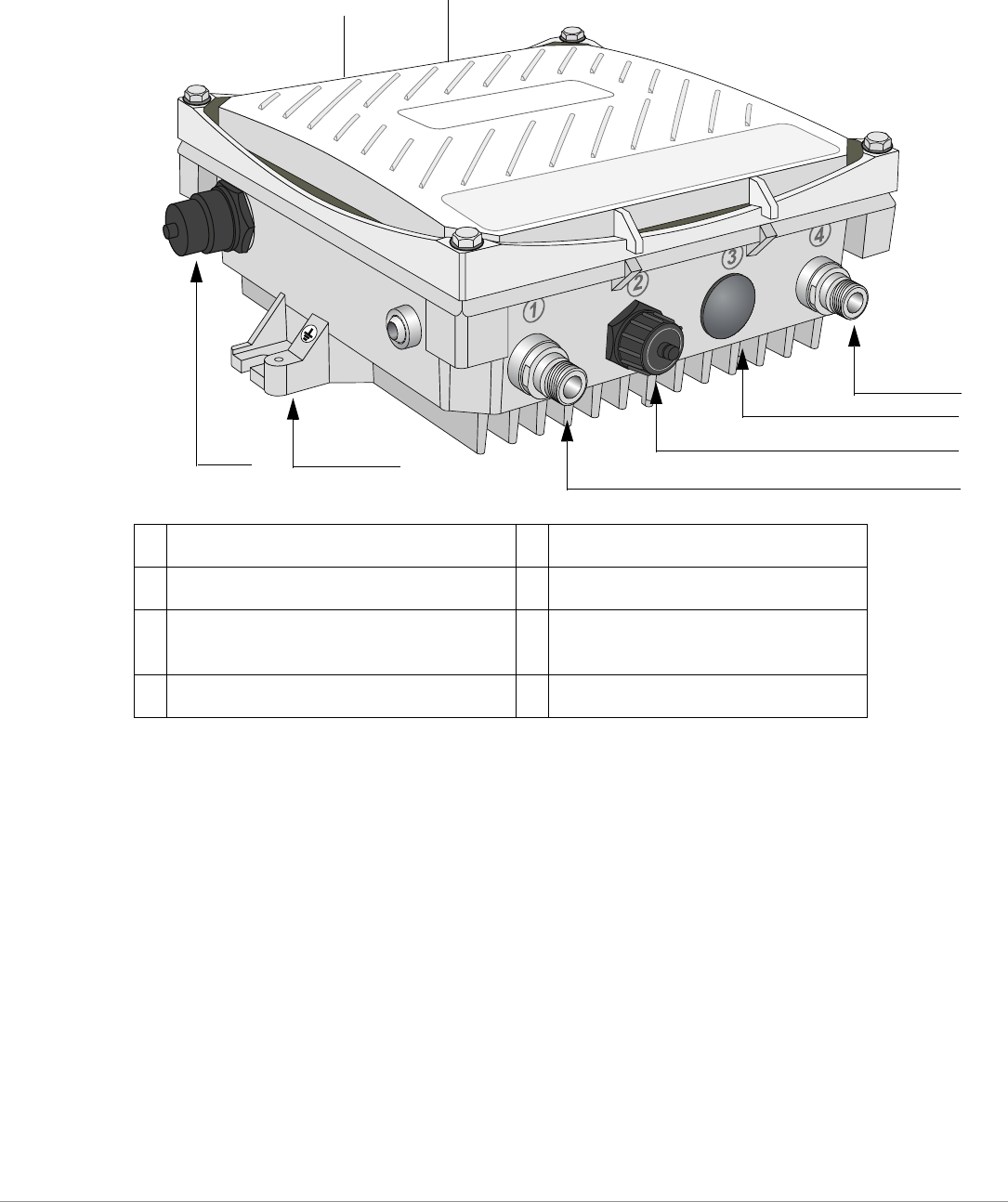
Aruba IAP-175 Outdoor Instant Access Point | Installation Guide 3
IAP-175 Hardware Overview
The following section describes the hardware features of the IAP-175.
Figure 1 IAP-175 Overview (IAP-175P shown)
Antenna Interface
The IAP-175 requires the use of detachable outdoor-rated antennas. Select the correct antenna type to
support the required frequency band (2.4 or 5 GHz) and the desired coverage pattern.
The IAP-175 is equipped with four, female N-type antenna interfaces; two on the top of the AP and two on
the bottom. The interfaces are grouped into diversity pairs, one pair is marked R0 (Radio 0) and the other
pair marked as R1 (Radio 1). R0 supports the 5 GHz frequency band and R1 supports the 2.4 GHz radio
band.
1 Antenna Interface (Radio 1) 5 Antenna Interface (Radio 0)
2 USB Console Interface 6 Antenna Interface (Radio 1)
3 Reserved (IAP-175P) or
Power Interface (IAP-175AC)
7 Ethernet Interface (PoE)
4 Antenna Interface (Radio 0) 8 Grounding Point
2
1
3
4
8
7
65
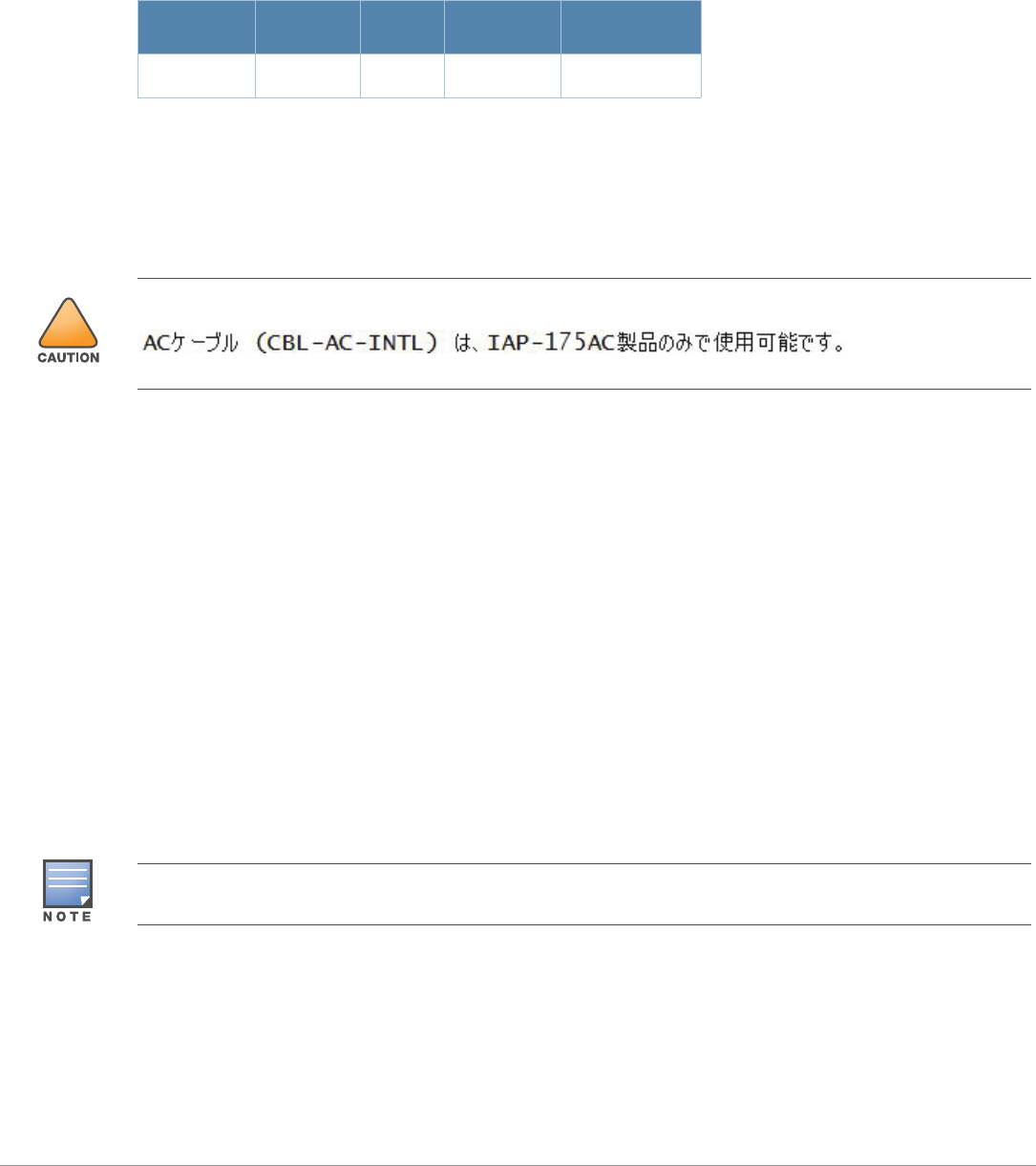
4Aruba IAP-175 Outdoor Instant Access Point | Installation Guide
USB Console Interface
A USB serial console port is provided for connection to a terminal, allowing direct local management. Use
the included USB console cable to connect to the AP. You can download the necessary driver for USB-
UART adapter from support.arubanetworks.com under the Tools & Resources tab.
Use the following setting to access the terminal:
Power Interface
The type of power interface on your IAP-175 depends on which model you have purchased.
IAP-175P: This version does not include a power interface since it is only powered by PoE+ (802.3at).
IAP-175AC: 1x AC power connector
Ethernet Interface
The IAP-175 is equipped with a 10/100/1000Base-T Gigabit Ethernet port for wired network connectivity. On
the IAP-175P, this port also supports IEEE 802.3at Power over Ethernet (PoE), accepting 48 VDC as a
standards-defined powered device (PD) from a power sourcing equipment (PSE) device, such as a PoE
midspan injector. Inversely, the IAP-175AC can act as a PSE device to provide IEEE802.3af PoE power to
devices connected to the Ethernet port.
Grounding Point
Always remember to protect your IAP-175 by installing grounding lines. The ground connection must be
complete before connecting power to the IAP-175 enclosure. Ensure that the resistance is less than 5 ohm
between the ground termination point and the grounding tier.
IAP-175P LED Status Indicators
The IAP-175 include visual indicators for power, link, and radio status. Additionally, each radio has a four-
LED array that indicates received signal strength (RSSI).
Table 1 Console Settings
Baud Rate Data Bits Parity Stop Bits Flow Control
9600 8 None 1 None
!
For the IAP-175AC, only use the AC power cord with model number CBL-AC-INTL.
The RSSI LED indicators represent varying degrees in the RSSI level. The absence of a signal is indicated by no
LED response, and full signal strength is indicated when all four LEDs are active and lit.

Aruba IAP-175 Outdoor Instant Access Point | Installation Guide 5
Figure 2 LED Layout
Table 2 lists the meanings of the LEDs on the IAP-175P outdoor access point.
Table 2 IAP-175P LED Status Indicators
LED Function Indicator Status
P/S AP Power/Ready
Status Off No power to AP
Blinking Device booting, not ready
On Device ready
POE N/A N/A Not currently used
ENT LAN/Network Link
Status Off Ethernet link unavailable
On (Amber) 10/100 Mbs Ethernet link
negotiated
On (Green) 1000 Mbs Ethernet link negotiated
Blinking Traffic on Ethernet link
R0 Radio 0 Status Off Radio 0 disabled
On (Amber) Radio 0 enabled in WLAN mode
Blinking Air Monitor (AM) mode
R1 Radio 1 Status Off Radio 1disabled
On (Blue) Radio 1 enabled in WLAN mode
Blinking Air Monitor (AM) mode
RSSI (Radio 0) RSSI Level for
Radio 0 Off RSSI disabled/no signal
4 Step Progressive
Bars (Red)
25/50/75/100%
Each bar represents a progressive
increase in signal strength, with 4
bars representing maximum signal
strength (100%).
Minimum data rate: One lit LEDs
Maximum data rate: Four lit LEDs
RSSI (Radio 1) RSSI Level for
Radio 1 Off RSSI disabled/no signal
4 Step Progressive
Bars (Blue)
25/50/75/100%
Each bar represents a progressive
increase in signal strength, with 4
bars representing maximum signal
strength (100%).
Minimum data rate: One lit LEDs
Maximum data rate: Four lit LEDs
P/S ENT
POE
RSSI for Radio 1
RSSI for Radio 0

6Aruba IAP-175 Outdoor Instant Access Point | Installation Guide
IAP-175AC LED Status Indicators
The IAP-175 include visual indicators for power, link, heat and radio status. Additionally, each radio has a
four-LED array that indicates received signal strength (RSSI).
Figure 3 LED Layout
Table 3 lists the meanings of the LEDs on the IAP-175AC outdoor access points.
The RSSI LED indicators represent varying degrees in the RSSI level. The absence of a signal is indicated by no
LED response, and full signal strength is indicated when all four LEDs are active and lit.
Table 3 IAP-175AC LED Status Indicators
LED Function Indicator Status
P/S AP Power/Ready
Status Off No power to AP
Blinking Device booting, not ready
On Device ready
POE Displays PSE
power output
status
Off Non-powered device
(0Ω<Rport<200Ω) or Port open
(Rport>1MΩ)
Green Port on (25kΩ)
1 Flash: Low signature
resistance (300Ω<Rport<15kΩ)
2 Flashes: High signature
resistance
(33kΩ<Rport<500kΩ)
5 Flashes: Port overload fault
9 Flashes: Power management
allocation exceeded
Heat Displays the
heating status of
low temperature
Off Unit is not in heating status
Blinking (Blue) Unit is pre-heating
ENT LAN/Network Link
Status Off Ethernet link unavailable
On (Amber) 10/100 Mbs Ethernet link
negotiated
On (Green) 1000 Mbs Ethernet link negotiated
Blinking Traffic on Ethernet link
P/S ENT
POE HEAT
RSSI for Radio 1
RSSI for Radio 0

Aruba IAP-175 Outdoor Instant Access Point | Installation Guide 7
Outdoor Planning and Deployment Considerations
Prior to deploying an outdoor wireless network, the environment must be evaluated to plan for a successful
Aruba WLAN deployment. Successfully evaluating the environment enables the proper selection of Aruba
APs and antennas and assists in the determination of their placement for optimal RF coverage. This process
is considered WLAN or RF planning and Aruba’s system engineers can assist in the outdoor planning
process.
Scale Requirements
The potentially immense scale of outdoor deployments requires consideration of factors that may not be as
important in a typical indoor deployment:
Range (distance): Range or distance between APs must be taken into account during the planning phase.
Available AP mounting locations are often far less flexible in an outdoor environment. Regardless of
these outdoor restrictions, the desired goal is to achieve results similar to an indoor deployment: a
“dense” RF deployment that supports advanced Aruba features, such as ARM, efficient client roaming,
and failover.
Elevation: Proper consideration and planning for elevation differences between APs (AP to AP) and AP
to Client can be critical to success. To plan for these differences in elevation, it is important to
understand the 3D coverage pattern provided by the antennas that will be deployed in the environment.
R0 Radio 0 Status Off Radio 0 disabled
On (Amber) Radio 0 enabled in WLAN mode
Blinking Air Monitor (AM) mode
R1 Radio 1 Status Off Radio 1disabled
On (Blue) Radio 1 enabled in WLAN mode
Blinking Air Monitor (AM) mode
RSSI (Radio 0) RSSI Level for
Radio 0 Off RSSI disabled/no signal
4 Step Progressive
Bars (Red)
25/50/75/100%
Each bar represents a progressive
increase in signal strength, with 4
bars representing maximum signal
strength (100%).
Minimum data rate: One lit LEDs
Maximum data rate: Four lit LEDs
RSSI (Radio 1) RSSI Level for
Radio 1 Off RSSI disabled/no signal
4 Step Progressive
Bars (Blue)
25/50/75/100%
Each bar represents a progressive
increase in signal strength, with 4
bars representing maximum signal
strength (100%).
Minimum data rate: One lit LEDs
Maximum data rate: Four lit LEDs
Table 3 IAP-175AC LED Status Indicators (Continued)
LED Function Indicator Status
Improper termination of access points installed in the United States configured to non_US model controllers will be
violation of the FCC Grant of equipment authorization. Any such willful or intentional violation may result in a
requirements by FCC to immediate termination of operation and my be subject to forfeiture (47 CFR 1.80).
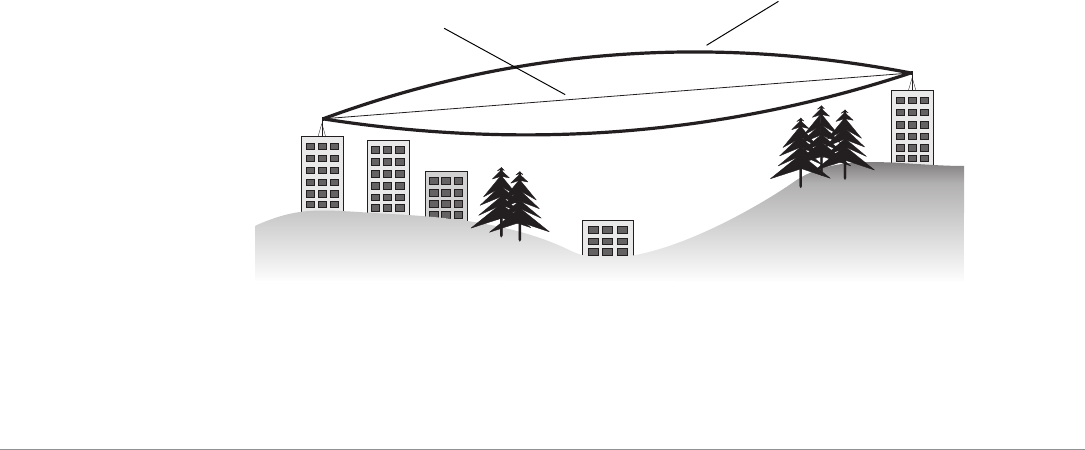
8Aruba IAP-175 Outdoor Instant Access Point | Installation Guide
Non-Fixed Considerations: The RF environment might change on a day to day basis. Keep non-fixed
items, such as shipping containers, vehicles, and future building construction, in mind when planning for
an outdoor deployment.
Identifying Known RF Absorbers/Reflectors/Interferences Sources
Identifying known RF absorbers/reflectors/interference sources while out in the field during the installation
phase is critical. Even though outdoor environments consist of fewer RF absorbers/reflectors/interference
sources compared to indoor environments, ensure that these sources are identified and taken into
consideration when installing and mounting an AP to its fixed outdoor location.
RF Absorbers
Cement/Concrete
Natural Items: Trees/vegetation
Brick
RF Reflectors
Metal Objects: Roof-installed air-conditioning equipment, chain link fences (depending on aperture
size), other wire fences, or water pipes
RF Interference Sources
Other 802.11a/b/g/n or broadband access equipment operating nearby
Industrial RF welding equipment or other Industrial, Scientific and Medical (ISM) equipment that utilizes
RF to heat or alter the physical properties of materials
Military, Commercial Aviation or Weather Radar Systems
Line of Sight (Radio Path Planning)
A wireless bridge or mesh link requires a “radio line of sight” between the two antennas for optimum
performance. The concept of radio line of sight involves the area along a link through which the bulk of the
radio signal power travels. This area is known as the first Fresnel Zone of the radio link. For a radio link, no
object (including the ground) must intrude within 60% of the first Fresnel Zone.
Figure 4 illustrates the concept of a good radio line of sight.
Figure 4 Line of Sight
If there are obstacles in the radio path, there may still be a radio link but the quality and strength of the
signal will be affected. Calculating the maximum clearance from objects on a path is important as it directly
Radio Line of Sight
Visual Line of Sight

Aruba IAP-175 Outdoor Instant Access Point | Installation Guide 9
affects the decision on antenna placement and height. It is especially critical for long-distance links, where
the radio signal could easily be lost.
When planning the radio path for a wireless bridge or mesh link, consider these factors:
Avoid any partial line of sight between the antennas
Be cautious of trees or other foliage that may be near the path, or may grow and obstruct the path.
Be sure there is enough clearance from buildings and that no building construction may eventually block
the path.
For very long distance links, the curvature of the earth (20 cm per km) may need to be considered in the
calculation of relative heights.
Check the topology of the land between the antennas using topographical maps, aerial photos, or even
satellite image data (software packages are available that may include this information for your area)
Avoid a path that may incur temporary blockage due to the movement of cars, trains, or aircraft.
Antenna Height
A reliable wireless bridge or mesh link is usually best achieved by mounting the antennas at each end high
enough for a clear radio line of sight between them. The minimum height required depends on the distance
of the link, obstacles that may be in the path, topology of the terrain, and the curvature of the earth (for
links over 3 miles).
For long-distance links, the AP may have to be mounted on masts or poles that are tall enough to attain the
minimum required clearance. Use the following table to estimate the required minimum clearance above
the ground or path obstruction (for 5 GHz bridge links).
Table 4 Antenna Minimum Height and Clearance Requirements
Total Link Distance
Max Clearance for
60% of First Fresnel
Zone at 5.8 GHz
Approximate Clearance
for Earth Curvature
Total Clearance
Required at
Mid-point of Link
0.25 mile (0.402 km) 4.6 ft (1.4 m) 0.007 ft (0.002 m) 4.6 ft (1.4 m)
0.5 mile (0.805 km) 6.2 ft (1.9 m) 0.03 ft (0.010 m) 6.2 ft (1.9 m)
1 mile (1.6 km) 8.9 ft (2.7 m) 0.13 ft (0.04 m) 8.9 ft (2.7 m)
2 miles (3.2 km) 12.5 ft (3.8 m) 0.5 ft (0.15 m) 13.1 ft (4.0 m)
3 miles (4.8 km) 15.4 ft (4.7 m) 1.0 ft (0.3 m) 16.4 ft (5.0 m)
4 miles (6.4 km) 17.7 ft (5.4 m) 2.0 ft (0.6 m) 19.7 ft (6.0 m)
5 miles (8 km) 20 ft (6.1 m) 3.0 ft (0.9 m) 23 ft (7.0 m)
7 miles (11.3 km) 23.6 ft (7.2 m) 6.2 ft (1.9 m) 30 ft (9.1 m)
9 miles (14.5 km) 27 ft (8.2 m) 10.2 ft (3.1 m) 37 ft (11.3 m)
12 miles (19.3 km) 30.8 ft (9.4 m) 18.0 ft (5.5 m) 49 ft (14.9 m)
15 miles (24.1 km) 34.4 ft (10.5 m) 28.0 ft (8.5 m) 62.7 ft (19.1 m)
To avoid any obstruction along the path, the height of the object must be added to the minimum clearance required
for a clear radio line of sight. Consider the following simple example, illustrated in Figure 5.
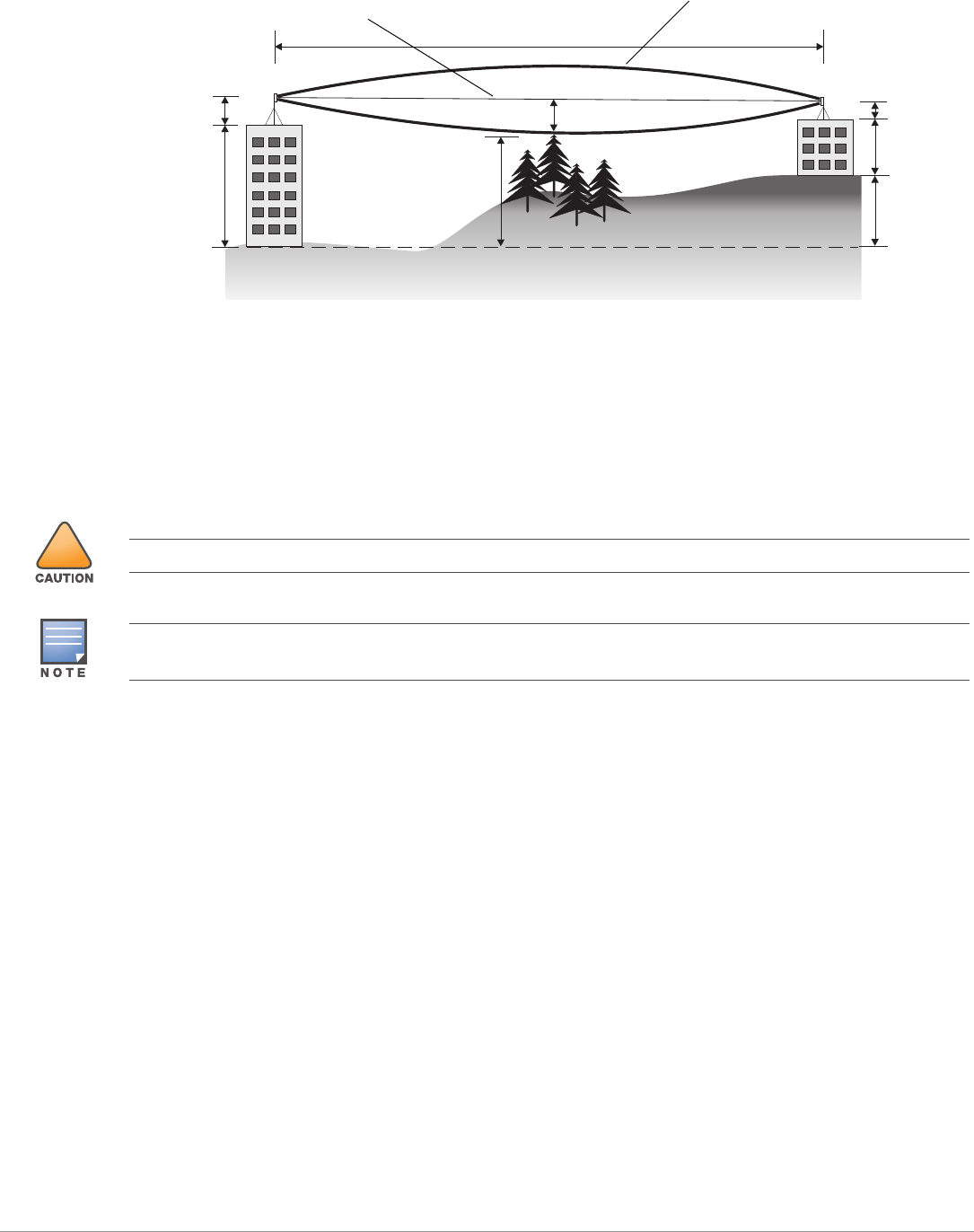
10 Aruba IAP-175 Outdoor Instant Access Point | Installation Guide
Figure 5 Antenna Height and Line of Sight
A wireless bridge or mesh link is deployed to connect building A to building B, which is located three miles
(4.8 km) away. Mid-way between the two buildings is a small tree-covered hill. From the above table it can
be seen that for a three-mile link, the object clearance required at the mid-point is 5.3 m (17.4 ft). The tree
tops on the hill are at an elevation of 17 m (56 ft), so the antennas at each end of the link need to be at least
22.3 m (73 ft) high. Building A is six stories high, or 20 m (66 ft), so a 2.3 m (7.5 ft) mast or pole must be
constructed on its roof to achieve the required antenna height. Building B is only three stories high, or 9 m
(30 ft), but is located at an elevation that is 12 m (39 ft) higher than building A. To mount an antenna at the
required height on building B, a mast or pole of 1.3 m (4.3 ft) is needed.
Antenna Position and Orientation
Once the required antenna height has been determined, other factors affecting the precise position of the
wireless bridge or mesh link must be considered:
Be sure there are no other radio antennas within 2 m (6 ft) of the wireless bridge or mesh link. These
include other WiFi radio antennas.
Place the wireless bridge or mesh link away from power and telephone lines.
Avoid placing the wireless bridge or mesh link too close to any metallic reflective surfaces, such as roof-
installed air-conditioning equipment, tinted windows, wire fences, or water pipes. Ensure that there is at
least 5 feet clearance from such objects.
The wireless bridge or mesh link antennas at both ends of the link must be positioned with the same
polarization direction, either horizontal or vertical. Proper alignment helps to maximize throughput.
Radio Interference
The avoidance of radio interference is an important part of wireless link planning. Interference is caused by
other radio transmissions using the same or an adjacent channel frequency. You should first scan your
proposed site using a spectrum analyzer to determine if there are any strong radio signals using the 802.11a/
b/g channel frequencies. Always use a channel frequency that is furthest away from another signal.
AB
3 miles (4.8 km)
5.4 m
17 m
20 m
2.4 m
12 m
9m
1.4 m
Radio Line of Sight
Visual Line of Sight
!
Never construct a radio mast, pole, or tower near overhead power lines.
Local regulations may limit or prevent construction of a high radio mast or tower. If your wireless bridge or mesh link
requires a high radio mast or tower, consult a professional contractor for advice.

Aruba IAP-175 Outdoor Instant Access Point | Installation Guide 11
If radio interference is still a problem with your wireless bridge or mesh link, changing the antenna
direction may improve the situation.
Weather Conditions
When planning wireless bridge or mesh links, you must take into account any extreme weather conditions
that are known to affect your location. Consider these factors:
Temperature: The wireless bridge or mesh link is tested for normal operation in temperatures from -30ºC
to 55ºC. Operating in temperatures outside of this range may cause the unit to fail.
Wind Velocity: The wireless bridge or mesh link can operate in winds up to 165 miles per hour. You must
consider the known maximum wind velocity and direction at the site and be sure that any supporting
structure, such as a pole, mast, or tower, is built to withstand this force.
Lightning: To protect against lightning induced surges, the IAP-175 requires lightning protection on the
radio interface ports.
Rain: The wireless bridge or mesh link is weatherproofed against rain. However, it is recommended to
apply weatherproof sealing tape around the Ethernet port and antenna connectors for extra protection.
If moisture enters a connector, it may cause a degradation in performance or even a complete failure of
the link.
Snow and Ice: Falling snow, like rain, has no significant effect on the radio signal. However, a buildup of
snow or ice on antennas may cause the link to fail. In this case, the snow or ice has to be cleared from
the antennas to restore operation of the link.
Ethernet Cabling
When a suitable antenna location has been determined, you must plan a cable route from the wireless
bridge or mesh link outdoors to a suitable power and/or network source.
Consider these points:
The Ethernet cable length should never be longer than 90 m (295 ft).
Determine a building entry point for the cable (if applicable).
Determine if conduits, bracing, or other structures are required for safety or protection of the cable.
For lightning protection at the power injector end of the cable, consider using a lightning arrestor
immediately before the cable enters the building
Grounding
It is important that the wireless bridge or mesh link, cables, and any supporting structures are properly
grounded. Each IAP-175 access point includes a grounding screw for attaching a ground wire. Be sure that
grounding is available and that it meets local and national electrical codes. Ground the access point first
using the external ground stud on the unit before making any other connection.
!
An Aruba Lightning Arrestor, AP-LAR-1, must be installed on each antenna port for protection against lightning
induced surges. Failure to use an AP-LAR-1 can void the warranty of an Aruba outdoor AP model and renders the
AP susceptible to failure from lightning induced surges

12 Aruba IAP-175 Outdoor Instant Access Point | Installation Guide
Installing Antennas
1. Before connecting the antennas, identify which of your antennas are 2.4 GHz and which are 5 GHz. On
the AP-175, the 2.4 GHz antennas must be installed the R1 radio interfaces and the 5.0 GHz must be
installed on the R0 radio interfaces.
2. After identifying which antennas will go where, install them by placing the antenna connector over the
corresponding connector and the AP and turning the connector clockwise until hand tight. Repeat this
process for each antenna.
3. Place the included metal weatherproof caps over any unused antenna interfaces by turning them
clockwise until hand tight.
Weatherproofing Connections
Weatherproofing your antenna and/or cable connections on your outdoor AP is essential to reliability and
longevity of your product. This process prevents water from entering the AP or antennas through the
connectors.
A good weatherproofing job consists of three wrappings:
1. electrical tape
2. butyl rubber
3. electrical tape
The first wrapping of tape should be at least two layers, followed by a single wrap of butyl rubber, and four-
layer wrap of electrical tape. This provides good protection from water, heat, and other potential hazards
that could damage your AP or antennas.
Additionally, wrap your connections such that water is always directed down and away from connections.
Required Items and Tools
3/4” (19 mm) Vinyl Electrical Tape
Butyl Rubber Tape
Knife or Box Cutter
Types of Connections
The following sections provide guidance on weatherproofing directly connected antennas (Figure 6) and
cable connections (Figure 7). The same materials are needed for weatherproofing both types of
connections but the procedure is slightly different. For weatherproofing directly connected antennas, see
"Weatherproofing Directly Connected Antennas" on page14. For weatherproofing cable connections, see
"Weatherproofing Cable Connections" on page17.
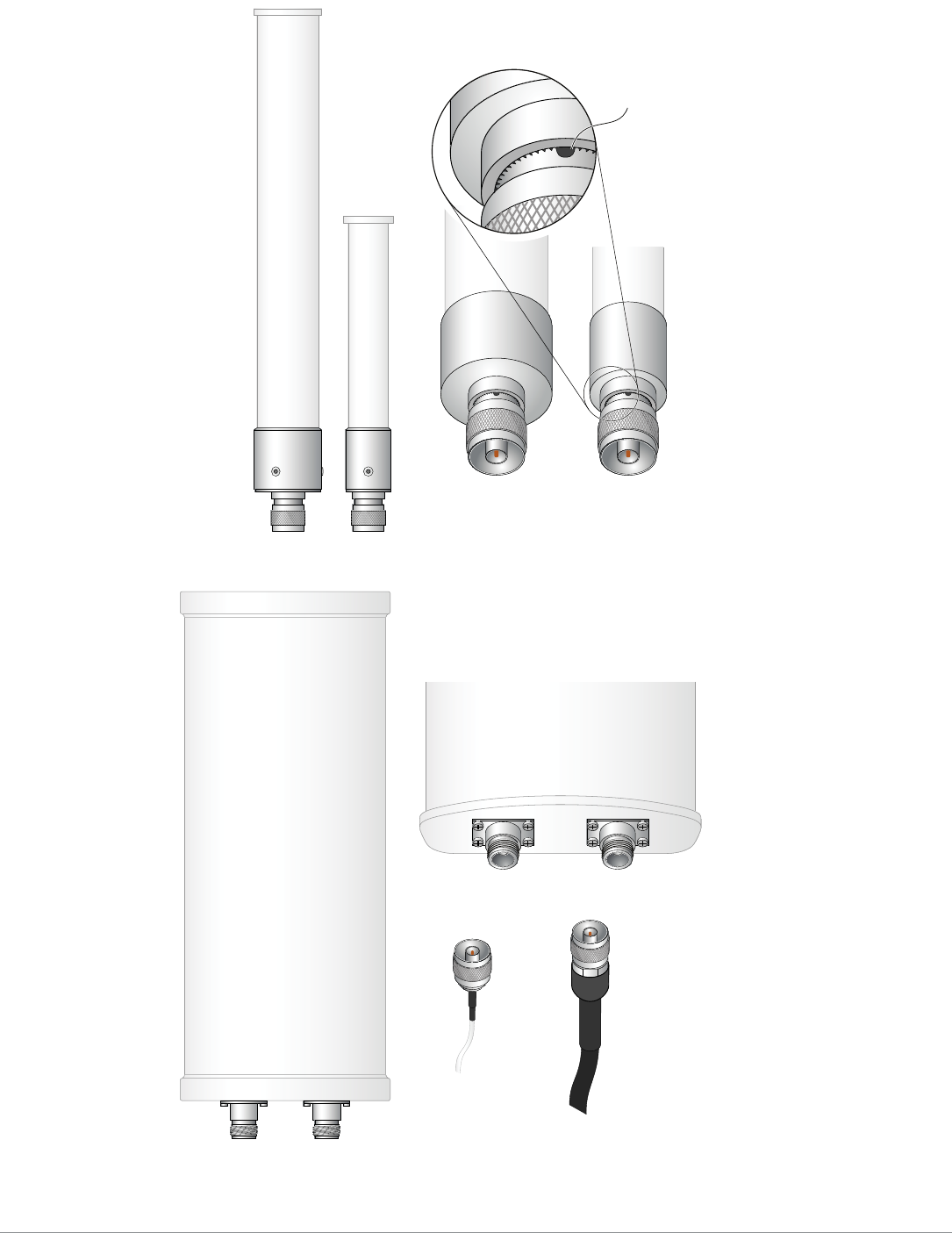
Aruba IAP-175 Outdoor Instant Access Point | Installation Guide 13
Figure 6 Directly Connected Antennas
Figure 7 Cable Connections
AP175_11
Weep holes
AP175_16
Connectors on bottom of antenna
N-type connector
on an RF cable
N-type
connector
on a pigtail
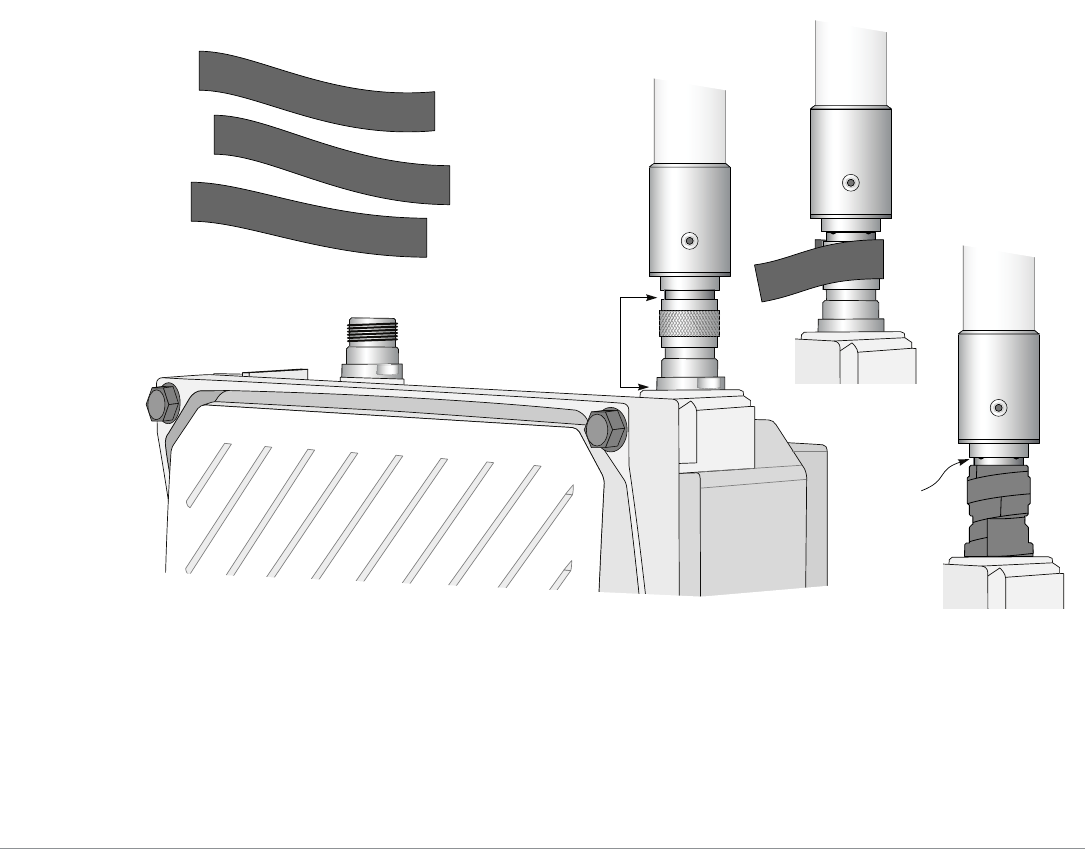
14 Aruba IAP-175 Outdoor Instant Access Point | Installation Guide
Important Points to Remember
Do not cover the weep holes on the antennas. Doing so can restrict the release of condensation from the
antennas.
Proper weatherproofing is not a fast process. Set aside ample time to complete the steps outlined below.
When wrapping, make the each layer of tape as flat as possible. Wrinkles and folds in the tape create
places for water and moisture to gather.
Weatherproofing Directly Connected Antennas
First Wrapping of Tape
1. Before wrapping the antennas, locate the weep holes (Figure 6). Weep holes allow condensation that
has built up inside the antenna to escape.
2. Prepare the antenna connector by cleaning and drying it.
3. Cut a 4” (100 mm) strip of electrical tape from the roll. Pre-cutting the tape into strips makes in easier to
maneuver the tape around the antennas and other components of the AP’s case.
4. Beginning just below the weep holes, tightly wrap the connection with a layer of the 3/4” (19mm)
electrical tape. Overlap the tape to a half-width.
5. Repeat steps 3 and 4 until the wrapping extends all the way to the AP’s case.
Figure 8 First Wrapping of Tape
Wrap tape from
just above knurled
section to base of
antenna mount
Pieces of tape as needed
Leave
weep holes
uncovered
AP175_12
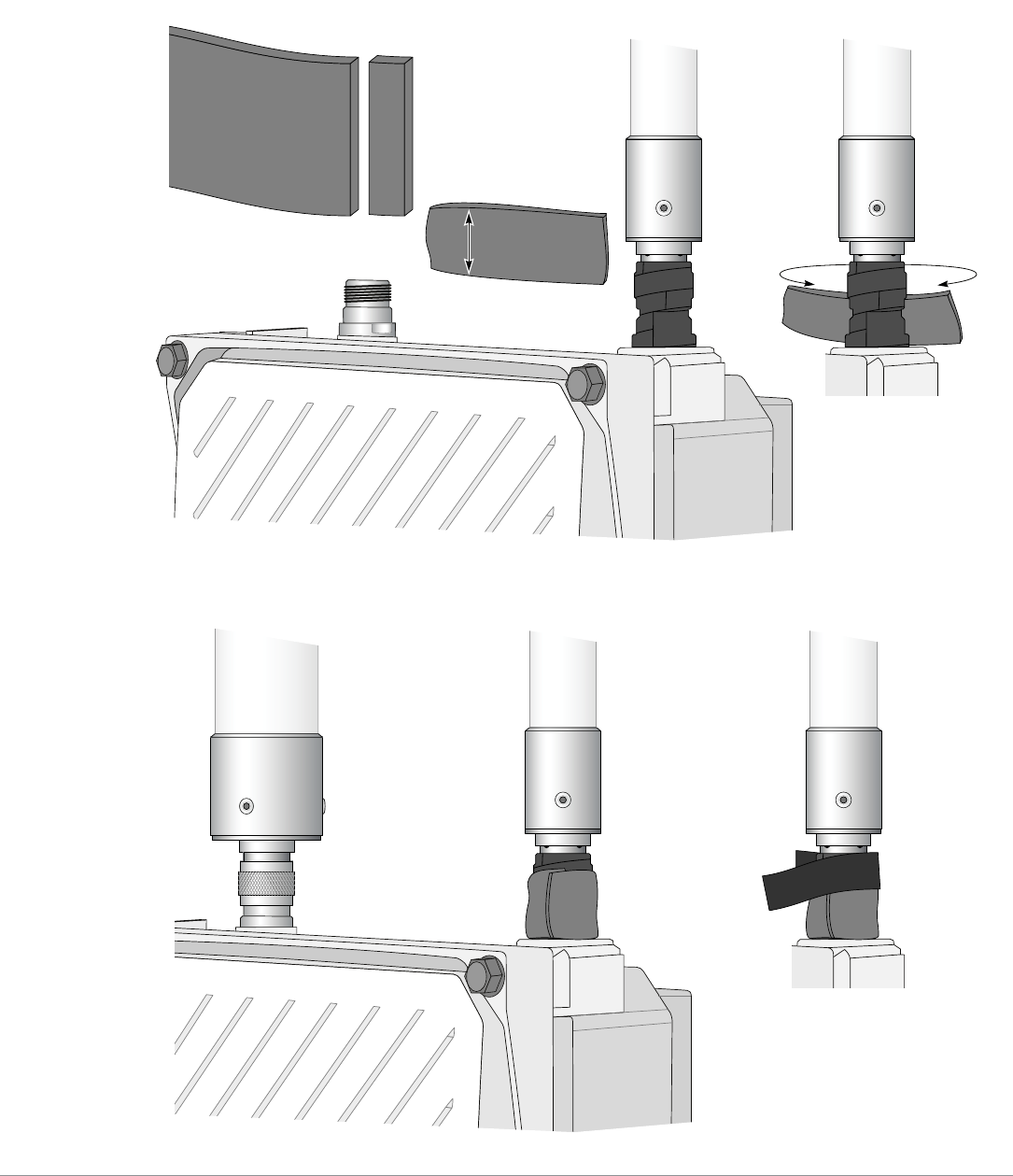
Aruba IAP-175 Outdoor Instant Access Point | Installation Guide 15
Wrapping of Butyl Rubber
1. Cut a 3/4” (19 mm) strip of butyl rubber.
2. Wrap the strip of rubber around the taped connector (Figure 9)
3. Join the two ends by pushing them together until there is no longer a seam (Figure 10).
Figure 9 Butyl Rubber Placement
Figure 10 Butyl Rubber Wrap
Cut 3/4” strip
of rubber
Squeeze thinner
& wider Wrap rubber
around base
of antenna
mount
AP175_13
Wrap rubber
around base
of antenna
mount
Squeeze to
bond rubber
to itself
Rubber will
be wrapped
with 4 layers
of tape
AP175_14
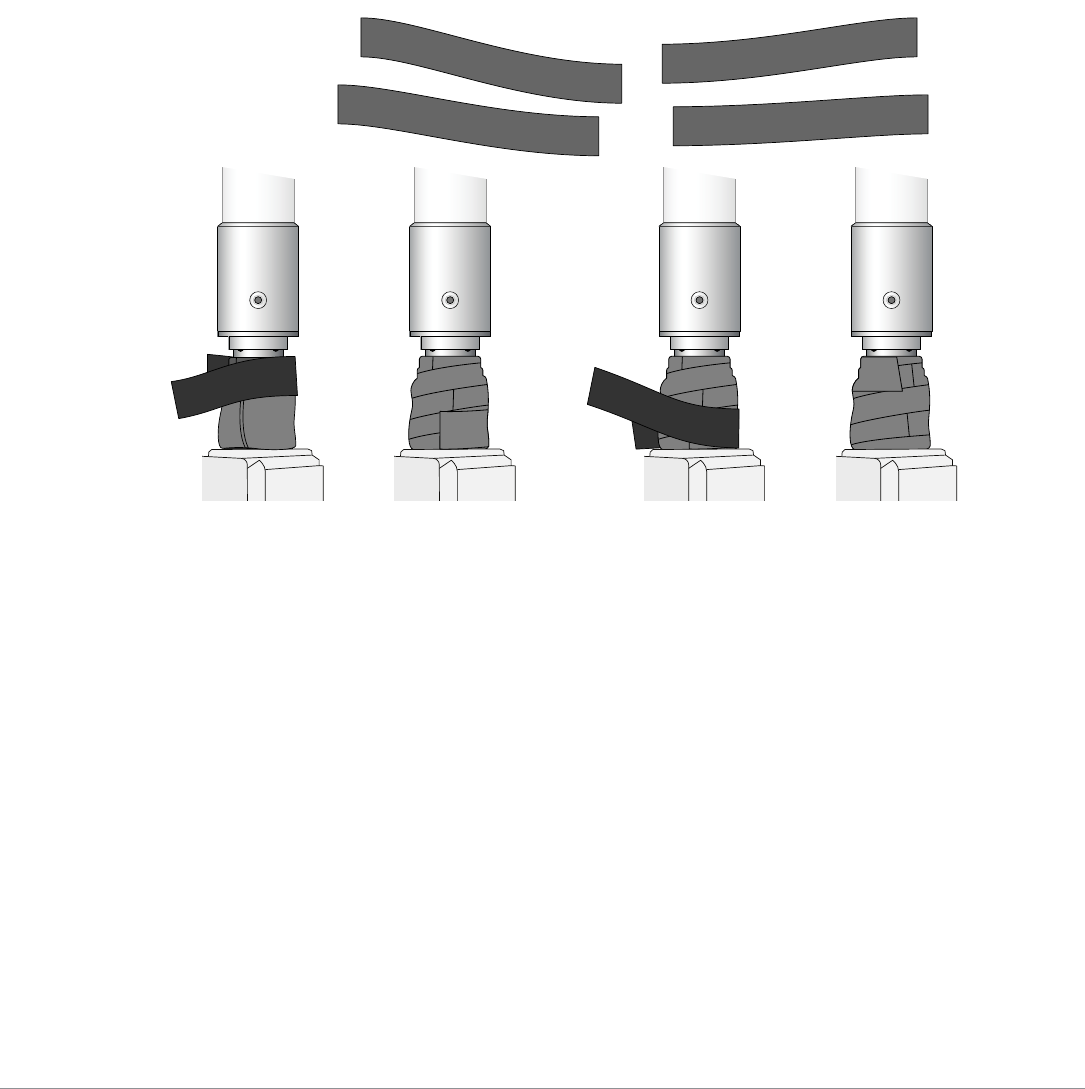
16 Aruba IAP-175 Outdoor Instant Access Point | Installation Guide
Second Wrapping of Tape
1. Cut a 4” (100 mm) strip of electrical tape from the roll.
2. Where you begin wrapping depends on the orientation of the antenna. Water should flow in the opposite
direction of the wrapping to prevent water from entering the connector between the layers of tape.
Therefore, if the antenna is facing up, you should begin wrapping at the AP end of the connector. This
will ensure that your fourth and final layer will be layered correctly. Conversely, if your antenna is facing
down, you should begin wrapping on the antenna end of the connector.
3. After completing the fourth layer of tape, check your work to ensure there are no places where water
can collect. If there are, you must smooth out those areas with additional layers of tape or remove the
weatherproofing and begin again.
Figure 11 Completed Wrapping (Antenna on Top of AP)
4. Repeat this process for all connectors.
First and third layers wrap
top to bottom
AP175_15
Rubber will
be wrapped
with 4 layers
of tape
Second and final layers wrap
bottom to top
Pieces of tape as needed
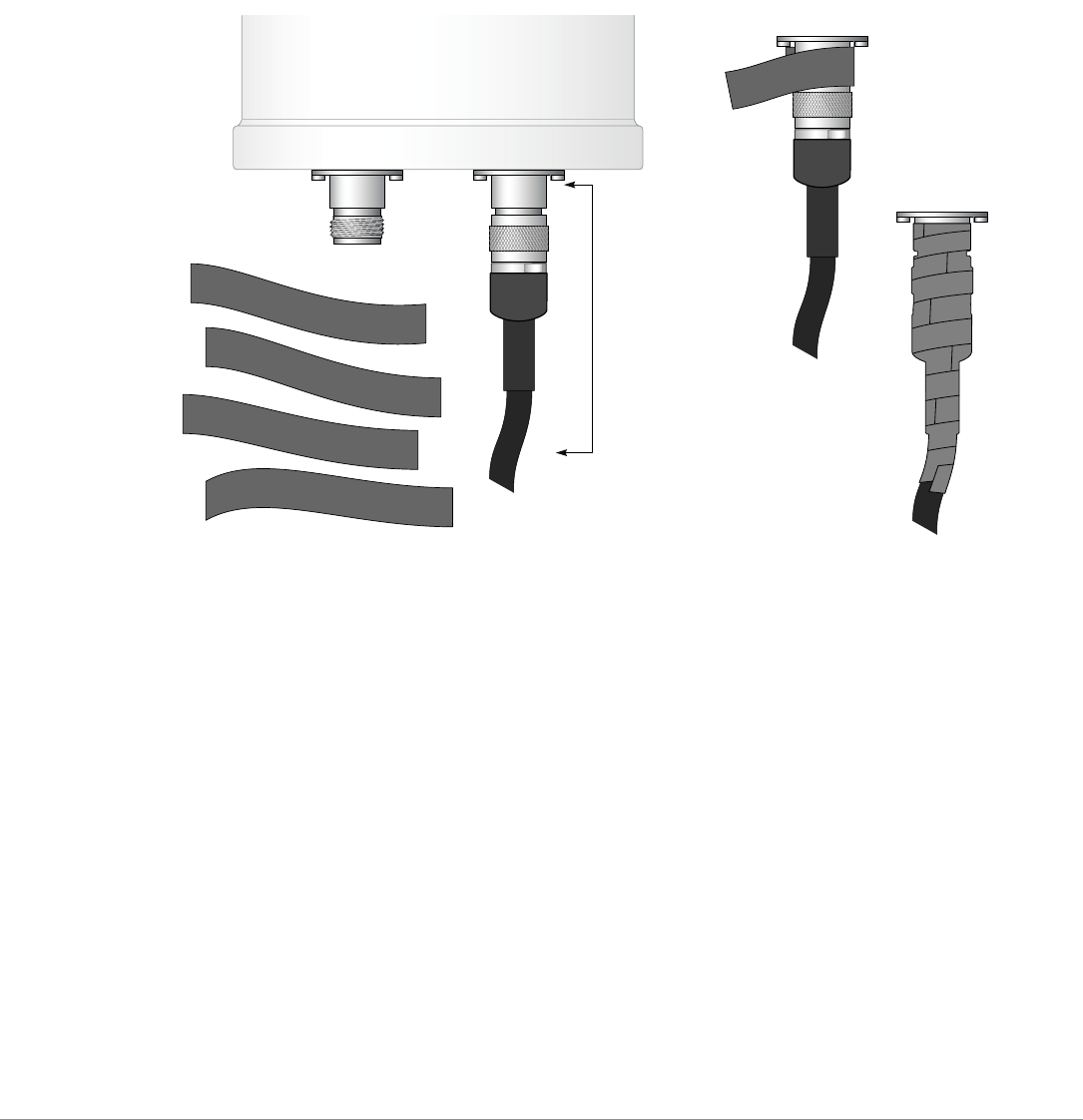
Aruba IAP-175 Outdoor Instant Access Point | Installation Guide 17
Weatherproofing Cable Connections
First Wrapping of Tape
1. Prepare the antenna connector by cleaning and drying it.
2. Cut a 4” (100 mm) strip of electrical tape from the roll. Pre-cutting the tape into strips makes in easier to
maneuver the tape around the connectors and other components but is not required.
3. Beginning at the top of the connector, tightly wrap the connection with a layer of the 3/4” (19mm)
electrical tape. Overlap the tape to a half-width.
4. Repeat steps 3 and 4 until the wrapping extends all the way to the cable’s insulation.
Figure 12 First Wrapping of Tape
Wrap tape
from antenna
connector base
to cable
Pieces of tape as needed
AP175_17
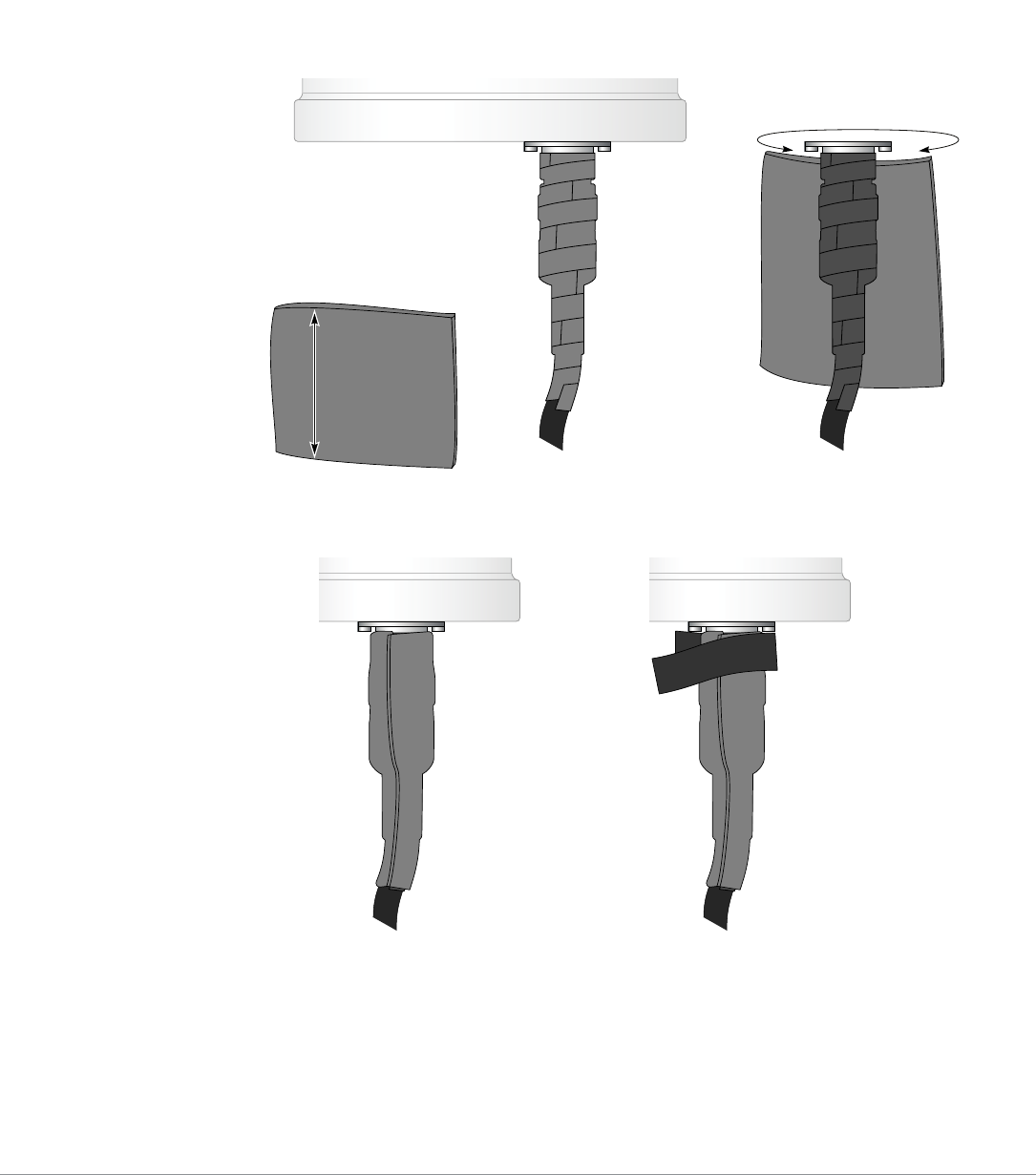
18 Aruba IAP-175 Outdoor Instant Access Point | Installation Guide
Wrapping of Butyl Rubber
1. Cut a piece of butyl rubber large enough to wrap around the connector and extended past the first layer
of tape.
2. Wrap the strip of rubber around the taped connector (Figure 13)
3. Join the two ends by pushing them together until there is no longer a seam (Figure 14).
Figure 13 Butyl Rubber Placement
Figure 14 Butyl Rubber Wrap
Stretch thinner
& wider
AP175_18
Wrap rubber
around connector
and cable
Squeeze to
bond rubber
to itself
Rubber will
be wrapped
with 4 layers
of tape
AP175_19
Wrap rubber
around connector
and cable
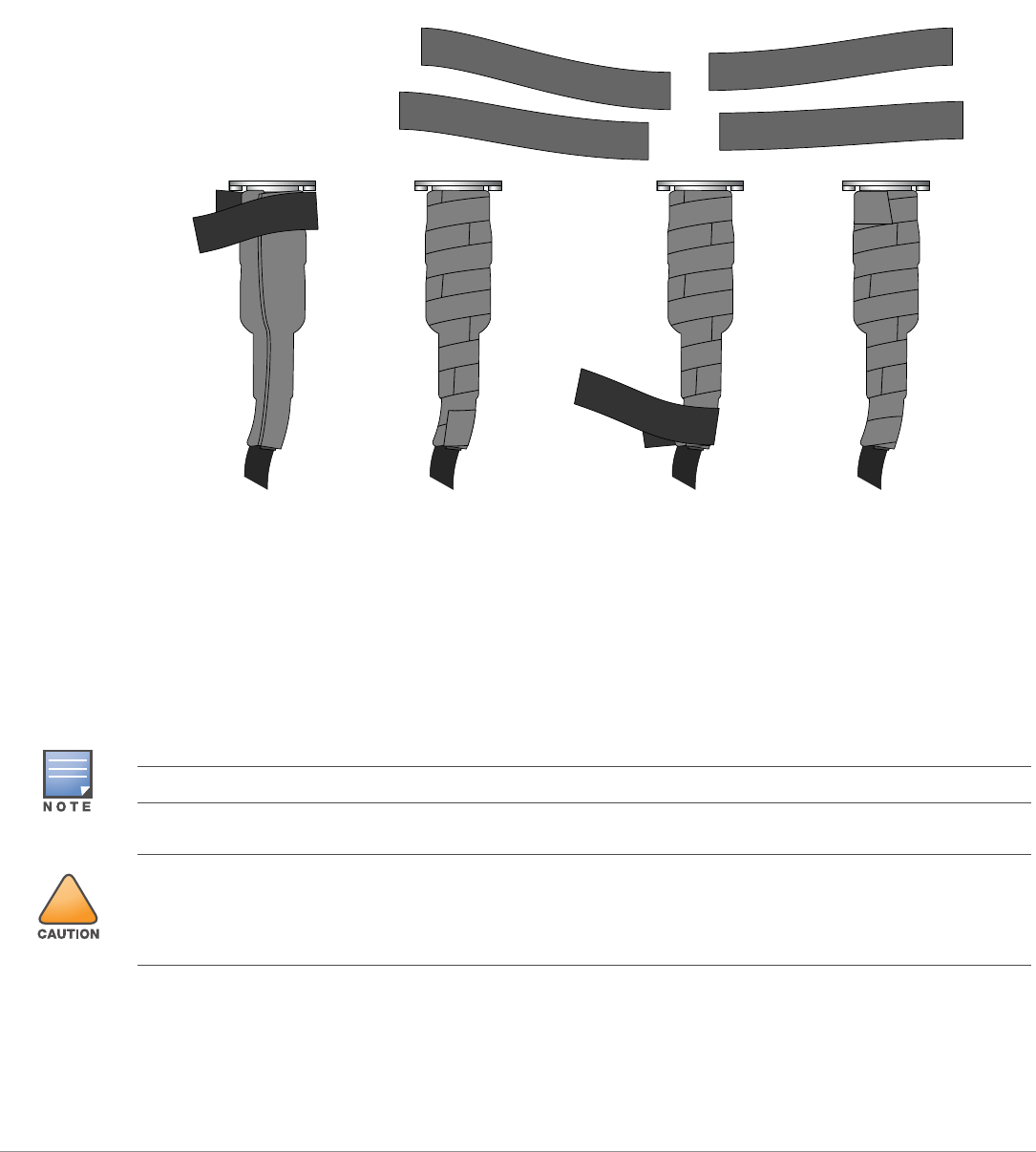
Aruba IAP-175 Outdoor Instant Access Point | Installation Guide 19
Second Wrapping of Tape
1. Cut a 4” (100 mm) strip of electrical tape from the roll.
2. Using 3/4” (19mm) electrical tape, begin wrapping at the connector and create four layers.
3. After completing the fourth layer of tape, check your work to ensure there are no places where water
can collect. If there are, you must smooth out those areas with additional layers of tape or remove the
weatherproofing and begin again.
Figure 15 Completed Wrapping
4. Repeat this process for all connectors.
Installing the IAP-175
The IAP-175 can be installed on a wall or attached to a pole. The following section describes how to attach
the necessary hardware to the AP and how to mount the AP in the selected location.
Selecting the Installation Site
The site should be located within at least a 60% range of the 1st fresnel zone without obstacles to provide
line of sight (LOS) transmission, increase coverage capacity, and minimize the number of necessary
sites.
First and third layers wrap
top to bottom
AP175_20
Pieces of tape as needed
Rubber will be wrapped
with 4 layers of tape
Second and final layers wrap
bottom to top
Service to all Aruba products should be performed by trained service personnel only.
!
Access points are radio transition devices and as such are subject to governmental regulation. Network
administrators responsible for the configuration and operation of access points must comply with local broadcast
regulations. Specifically, access points must use channel assignments appropriate to the location in which the
access point will be used and comply with regulatory requirements for Outdoor intentional radiators.
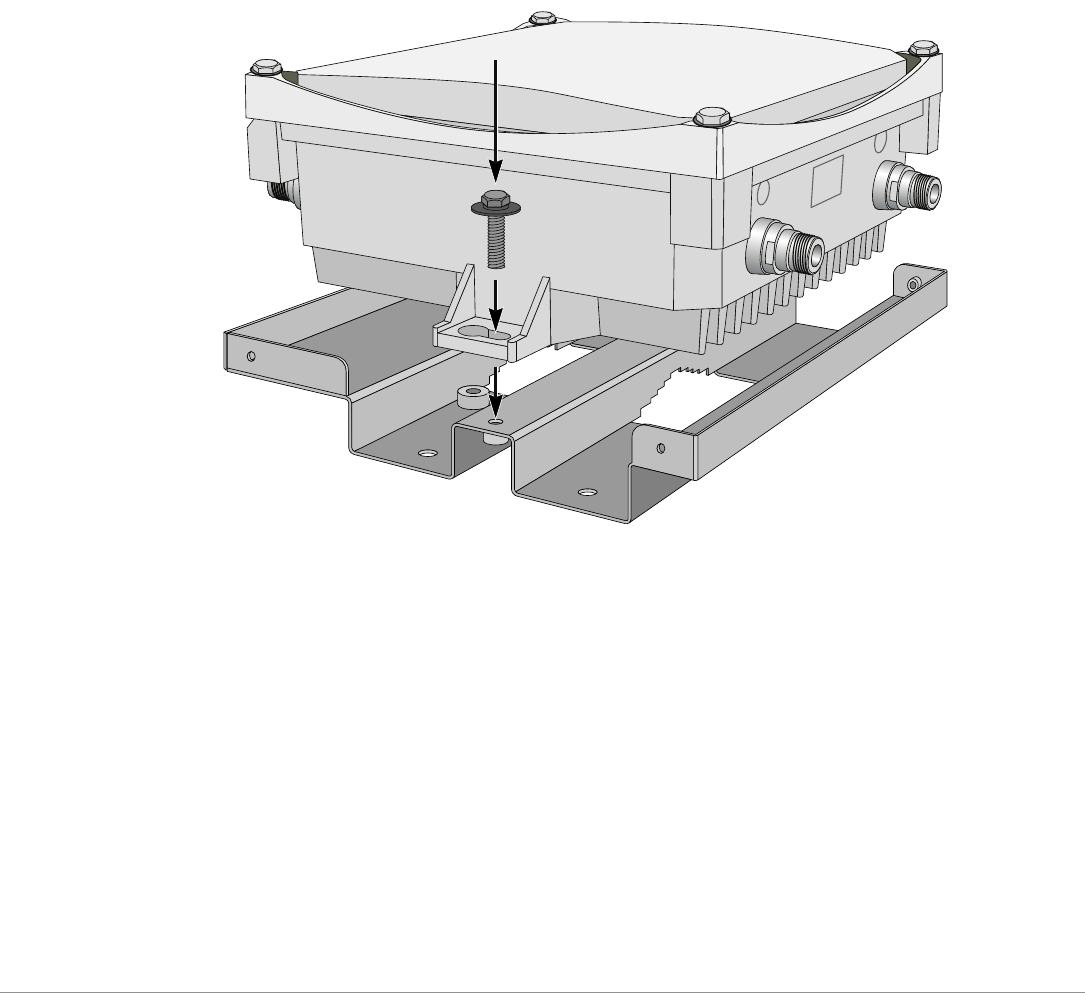
20 Aruba IAP-175 Outdoor Instant Access Point | Installation Guide
If no LOS is secured, areas in non-line-of-sight (NLOS) areas could be covered as well, but the distance
of coverage and area of coverage are decreased; more sites are needed to provide coverage for same
area than in the LOS scenario.
Interference must be considered in site selection. The new site should avoid known interference, unless
the interference is controllable.
Keep the IAP-175 away from places that are susceptible to high temperature, dust, harmful gas,
inflammable, explosive, electromagnetic interference (high power radar, radio station and transformer),
unstable voltage, heavy vibration, or loud noise. In engineering design, the site should be selected
according to the network planning and technical requirements of communications equipment, as well as
the considerations such as climate, hydrology, geology, earthquake, electric power, and transportation.
Installing the IAP-175 on a Pole
1. Attach the IAP-175 on the mounting bracket using the two M6 x30 bolts (with flat and spring washers)
on each side of the mounting bracket.
Figure 16 Attaching the mounting bracket to the AP
2. Attach the mounting bracket (with IAP-175) on the pole using four M8 x110 bolts (with flat washers,
spring washers and nuts) and the pair of pole anchors.
AP175_03
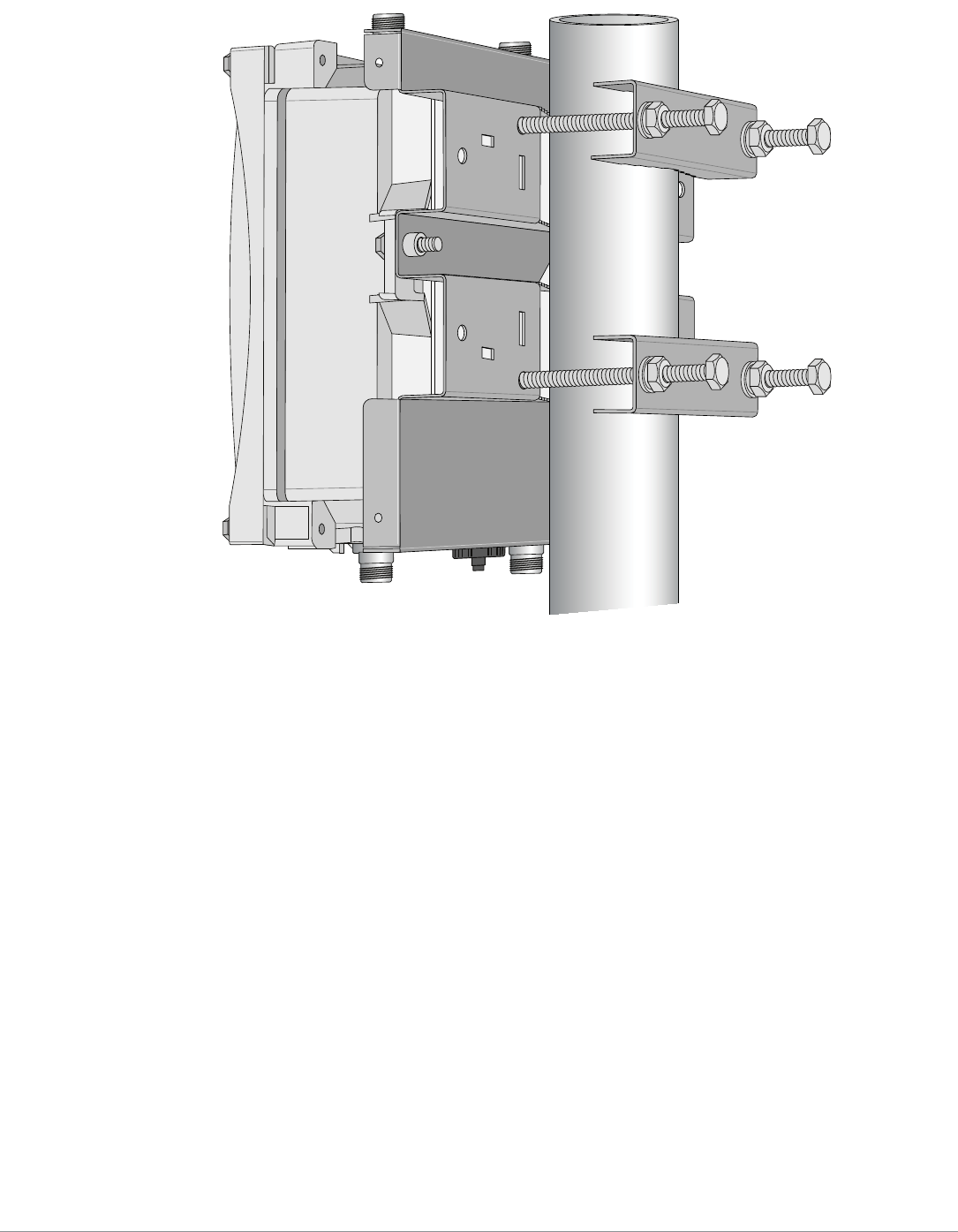
Aruba IAP-175 Outdoor Instant Access Point | Installation Guide 21
Figure 17 Attaching the mounting bracket to the pole
Installing the IAP-175 on a Wall
1. Begin by marking the screw points on the wall in the location you have selected.
a. Put the mounting bracket on the installation position against the wall.
b. Mark four expansion screw holes on the wall.

22 Aruba IAP-175 Outdoor Instant Access Point | Installation Guide
Figure 18 Position of the screw holes
2. Use a drill to create four holes on the four markings you created in the previous step.
3. Install wall (masonry) anchors.
a. Insert a masonry anchor into each drilled hole.
b. Tap the flat end of the anchor with a rubber hammer until the anchor is flush with the wall surface.
4. Attach the mounting bracket to the wall.
a. Align the four holes in the mounting bracket with the anchors and insert four expansion screws
through the installation holes into the anchors.
b. Adjust the position of the mounting bracket and tighten the expansion screws.
5. Attach the IAP-175 to the mounting bracket by inserting the two M6 x30 bolts (with flat and spring
washers) through the installation holes, and tighten the bolts.
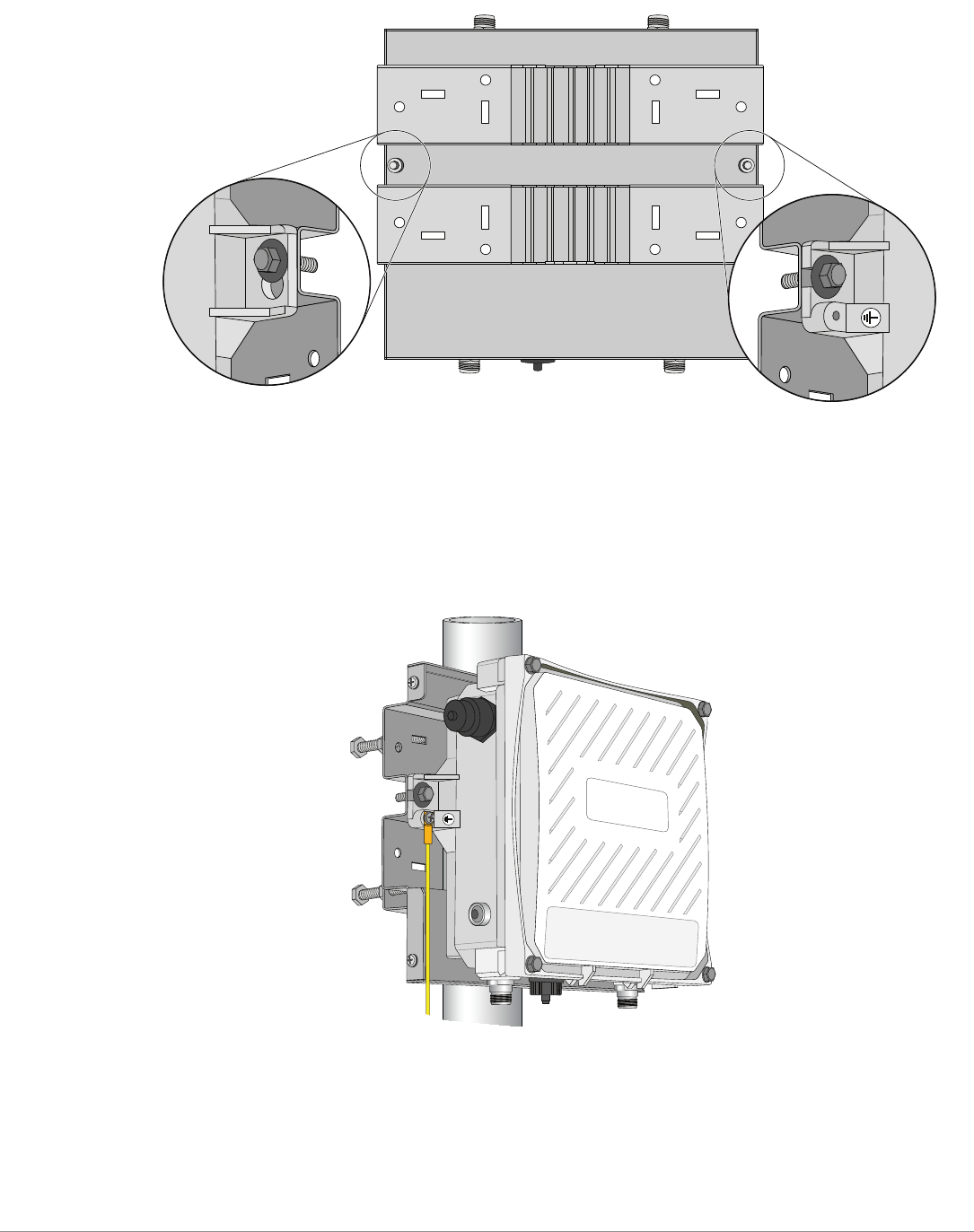
Aruba IAP-175 Outdoor Instant Access Point | Installation Guide 23
Figure 19 Attaching the AP to the Mounting Bracket
Grounding the IAP-175
The grounding must be completed before powering up the IAP-175. The resistance of grounding wire should
be less than 5 ohm and the grounding cable’s cross-section area should be no less than 6 mm.The grounding
hole is at the right side of the IAP-175.
Figure 20 Grounding the IAP-175
1. Peel the cover of one end of the grounding cable (green or yellow and green grounding cable with 6 mm
cross-section area) and place the bare grounding cable into the copper lug, and press firmly with the
crimping pliers.
2. Fasten the copper lug to the grounding hole on the IAP-175 with the M4 x12 bolt and external-tooth
washer.
Front
Front
AP175_04
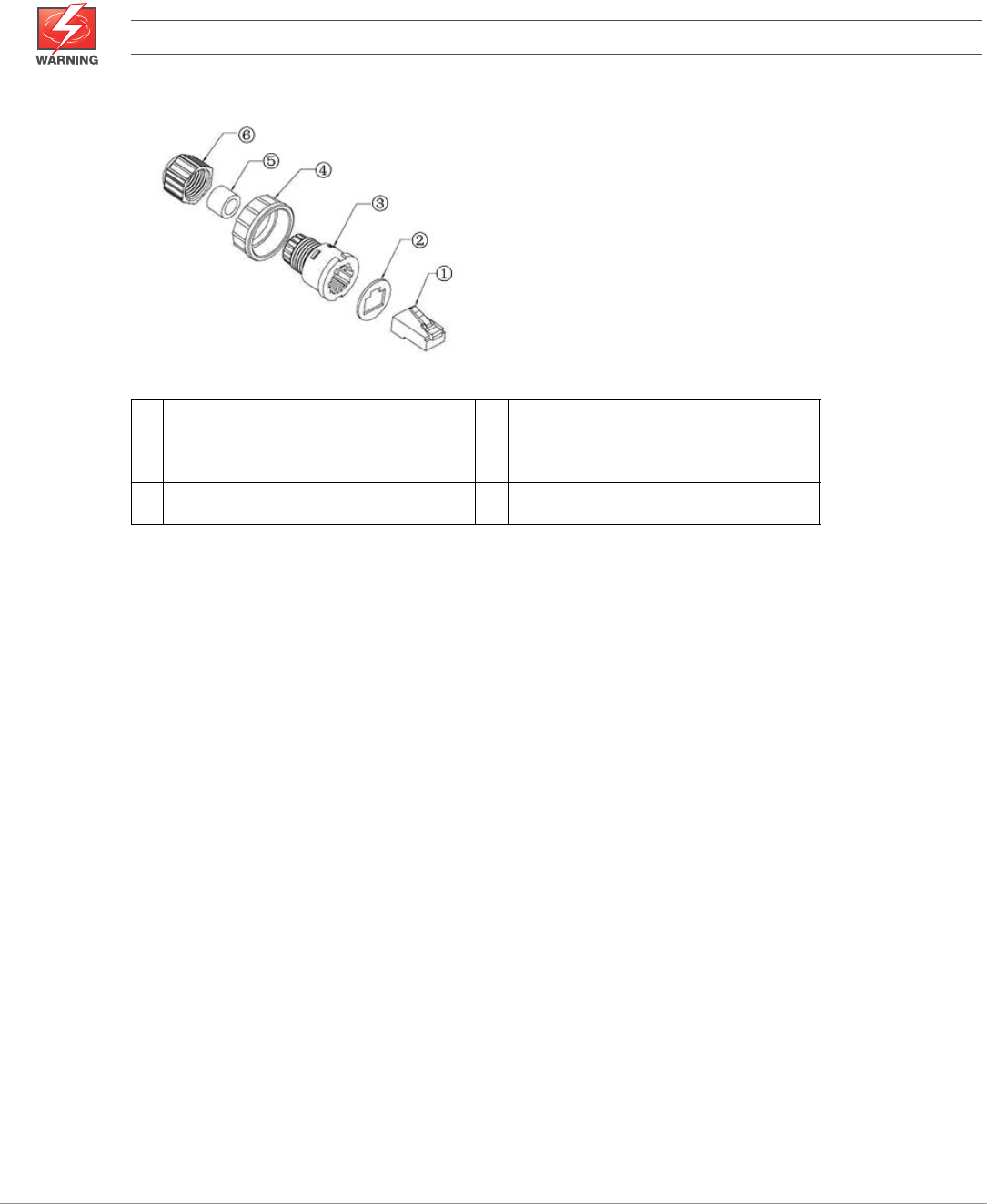
24 Aruba IAP-175 Outdoor Instant Access Point | Installation Guide
Connecting the Ethernet Cable (IAP-175P)
To ensure that your outdoor access point (AP) maintains Ethernet connectivity and Power over Ethernet
(PoE), you must use the included weatherproof connector kit and install it using the steps below.
Figure 21 Waterproof Ethernet Connector Cover
1. Remove the cover from the adhesive side of the gasket mat and place it over the weatherproof
connector socket.
2. Place the locknut over the weatherproof connector socket.
3. Place the sealing nut over an ethernet cable (without a connector attached to the end).
4. Place the seal ring over the ethernet cable.
5. Insert the ethernet cable into the narrow end of the weatherproof connector socket and pass it through
the opening on the wide end.
6. Using a crimping tool, attach the included shielded RJ45 connector.
7. Slide the seal ring up the ethernet cable and insert it into the narrow end of the weatherproof connector
socket.
8. Pull the ethernet cable so the shielded RJ45 connector fits into the RJ45 shaped opening in the wide end
of the weatherproof connector socket.
9. Slide the sealing nut over the narrow end of the weatherproof connector socket and hand tighten it.
10. Insert the ethernet cable connector into the Ethernet interface and hand-tighten the locknut.
11. Water-proof the Ethernet cable connection with electrical tape and butyl rubber.
Failure to use the included weatherproof connector kit can lead to connectivity and PoE issues.
1 Shielded RJ45 connector 4 Locknut
2Gasket Mat 5Seal Ring
3 Waterproof Connector Socket 6 Sealing Nut
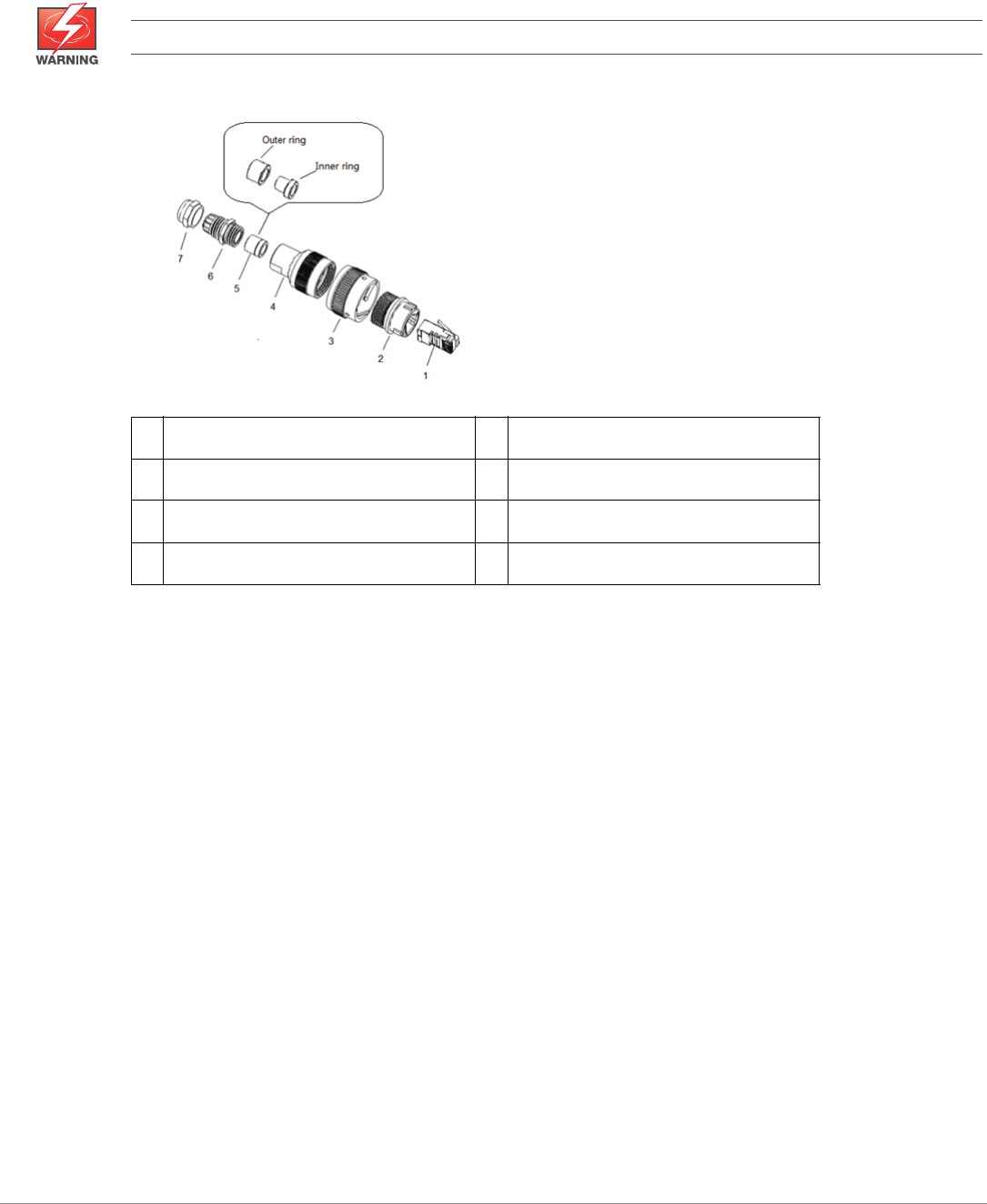
Aruba IAP-175 Outdoor Instant Access Point | Installation Guide 25
Connecting the Ethernet Cable (IAP-175AC)
To ensure that your outdoor access point (AP) maintains Ethernet connectivity and Power over Ethernet
(PoE), you must use the included weatherproof connector kit and install it using the steps below.
Figure 22 Waterproof Ethernet Connector Cover
1. Hold the clamp ring (4) vertically, with the wide end facing up, and place the locknut (3) over it.
2. Drop the waterproof connector socket (2) into the locknut/clamp ring items (3,4), with the RJ45
connector opening facing up, and screw the socket into the threads on the clamp ring.
3. Place the sealing nut (7) over an Ethernet cable (without a connector attached to the end).
4. Place the seal bolt (6) over the Ethernet cable.
5. Strip off about 55mm (2 inches) of the outer Ethernet cable sheath to expose the ground wire and other
pair wires.
6. Insert all pair wires into the two shield rings (5).
7. Make the ground wire attach to the narrow end of the inner ring and place the outer ring over the narrow
end of the inner ring.
8. Insert the Ethernet cable into the narrow end of the clamp ring and pass it through the opening end of
waterproof connector socket.
9. Using a crimping tool, attach the included shielded RJ45 connector.
10. Slide the shield rings up the Ethernet cable and insert it into the narrow end of the clamp ring.
11. Pull the Ethernet cable so the shielded RJ45 connector fits into the RJ45 shaped opening in the wide end
of the weatherproof connector socket.
12. Slide the sealing bolt over the narrow end of the clamp ring and hand tighten it.
13. Thread the sealing nut onto the sealing bolt.
14. Insert the Ethernet cable connector into the Ethernet interface and hand-tighten the locknut.
15. Water-proof the Ethernet cable connection with electrical tape and butyl rubber.
Failure to use the included weatherproof connector kit can lead to connectivity and PoE issues.
1 Shielded RJ45 connector 5 Shield rings
2 Waterproof Connector Socket 6 Sealing Bolt
3 Locknut 7 Sealing Nut
4 Clamp ring
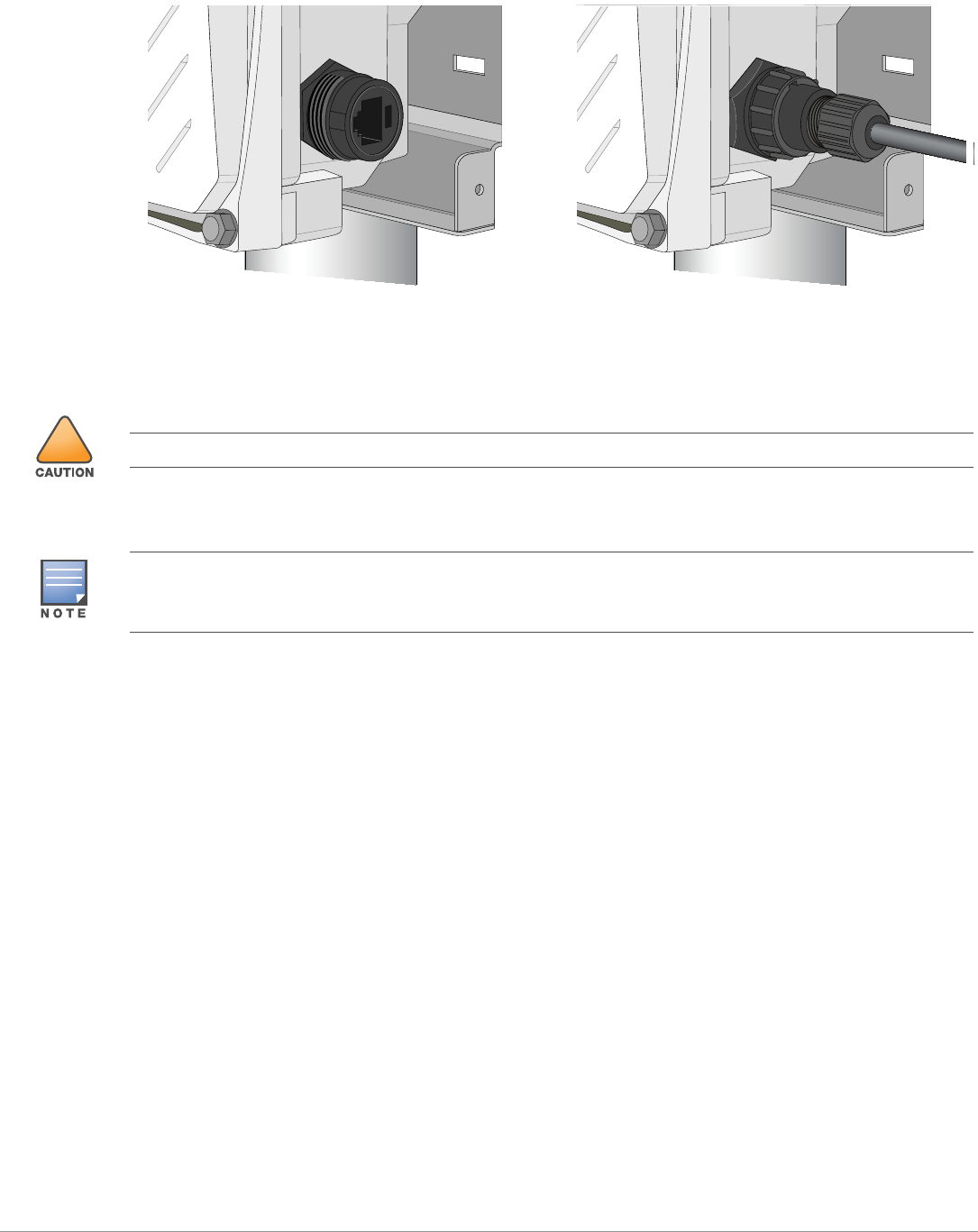
26 Aruba IAP-175 Outdoor Instant Access Point | Installation Guide
Figure 23 Connecting the Ethernet cable
Connecting the Power Cable (IAP-175 AC)
The IAP-175AC versions need an outdoor rated power cable to connect to a compatible AC power source.
AC power source specifications (at AP-175 interface): 100-240Vac, 100W
AC power cable specifications (when using AC connector kit and custom cable): minimum voltage/
current rating 250V/1A, diameter 6-12mm, rated for outdoor use
Cable Connection Steps
1. Remove the protective cap on the power interface.
2. Insert the power cable connector into the power interface and hand-fasten the waterproof cover.
3. Water-proof the power cable connection with PVC insulation tape, adhesive insulation tape and strap.
!
Installation and service of Aruba Networks products should be performed by Professional Installers.
The AP-175 does not ship with any power cables; these are available as accessories and should be ordered
separately. In addition to completed power cables, Aruba also offers an outdoor rated AC connector kit that can be
used to connect a compatible power cable to the AP-175.
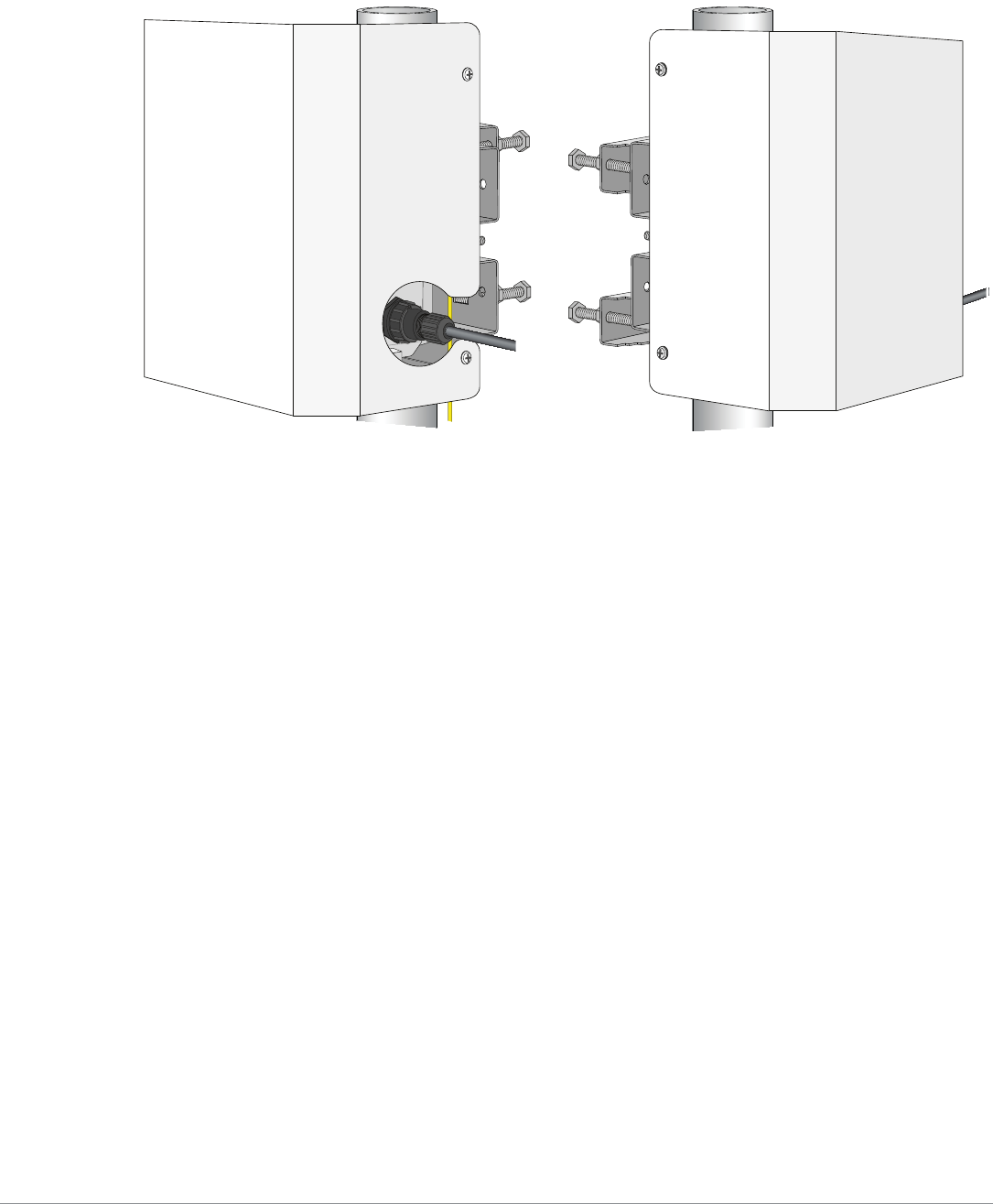
Aruba IAP-175 Outdoor Instant Access Point | Installation Guide 27
Attaching the Solar Shield to the IAP-175
Attach the solar shield to the IAP-175 by using the four M4 x16 (with flat and spring washers).
Figure 24 Attaching the Solar Shield to the AP
AP175_07
AP175_08

28 Aruba IAP-175 Outdoor Instant Access Point | Installation Guide
Product Specifications
Mechanical
Dimensions (H x W x D)
10.2 inches x 9.4 inches x 4.1 inches
26 cm x 24 cm x 10.5 cm
Weight: 7 lbs/3.25 kg
Shipping Dimensions (H x W x D)
12.9 inches x 12.6 inches x 11.8 inches
33 cm x 32 cm x 30 cm
Shipping Weight: 16.6 lbs/7.5 kg
Temperature
Operating (IAP-175P): -30ºC to 60ºC (-22ºF to 140ºF)
Operating (IAP-175AC): -40ºC to 55ºC (-40ºF to 131ºF)
Storage: –40ºC to 70ºC (-40ºF to 158ºF)
Relative Humidity: 5% to 95% non-condensing
Altitude: Up to 9,850ft (3,000 meters)
Mounting: wall or pole mountable
Antennas:
Quad, N-type female interfaces (2 x 2.4 GHz, 2 x 5GHz) for external antenna support (supports
MIMO)
Feeder cable may be used for external antenna deployments
Visual Status Indicators (LEDs): See Table 2
Electrical
Power In
IAP-175P: 48-volt DC 802.3at power over Ethernet (PoE+)
IAP-175AC: 100-240 volt AC from external AC power source
Maximum power consumption: 18 watts (excludes power consumed by any POE device connected to
and powered by the IAP-175AC)
Power Out
The AC powered models provide an 802.3af POE power source (PSE) on the Ethernet interface.
Interfaces
Network:
1 x 10/100/1000BASE-T Ethernet (RJ-45), auto-sensing link speed and MDI/MDX
Power:
1 x AC power connector (in IAP-175AC model only)
Antenna:
4 x N-Type female antenna interfaces
Other:

Aruba IAP-175 Outdoor Instant Access Point | Installation Guide 29
1 x USB console interface
Wireless LAN
AP type: Dual-radio, dual-band 802.11n outdoor
Supported frequency bands (country-specific restrictions apply):
2.400 to 2.4835 GHz
5.150 to 5.250 GHz
5.250 to 5.350 GHz
5.470 to 5.725 GHz
5.725 to 5.850 GHz
Available channels: Virtual controller-managed, dependent upon configured regulatory domain
Supported radio technologies:
802.11b: Direct-sequence spread-spectrum (DSSS)
802.11a/g/n: Orthogonal frequency division multiplexing (OFDM)
802.11n: 2x2 MIMO with two spatial streams
Supported modulation types:
802.11b: BPSK, QPSK, CCK
802.11a/g/n: BPSK, QPSK, 16-QAM, 64-QAM
Transmit power: Configurable in increments of 0.5 dBm
Maximum transmit power:
2.4 GHz: 25 dBm (limited by local regulatory requirements)
5 GHz: 25 dBm (limited by local regulatory requirements)
Maximum ratio combining (MRC) for improved receiver performance
Association rates (Mbps):
802.11b: 1, 2, 5.5, 11
802.11a/g: 6, 9, 12, 18, 24, 36, 48, 54
802.11n: MCS0 - MCS15 (6.5 Mbps to 300 Mbps)
802.11n high-throughput (HT) support: HT 20/40
802.11n packet aggregation: A-MPDU, A-MSDU

30 Aruba IAP-175 Outdoor Instant Access Point | Installation Guide
Safety and Regulatory Compliance
Aruba Networks provides a multi-language document that contains country-specific restrictions and
additional safety and regulatory information for all Aruba access points. This document can be viewed or
downloaded from the following location: www.arubanetworks.com/safety_addendum
FCC
The device will be electronically labeled and the FCC ID will be displayed via the controller Web UI under
the About menu.
This equipment has been tested and found to comply with the limits for a Class B digital device, pursuant to
part 15 of the FCC Rules. These limits are designed to provide reasonable protection against harmful
interference in a residential installation. This equipment generates, uses and can radiate radio frequency
energy and, if not installed and used in accordance with the instructions, may cause harmful interference to
radio communications. However, there is no guarantee that interference will not occur in a particular
installation. If this equipment does cause harmful interference to radio or television reception, which can be
determined by turning the equipment off and on, the user is encouraged to try to correct the interference by
one or more of the following measures:
Reorient or relocate the receiving antenna.
Increase the separation between the equipment and receiver.
Connect the equipment into an outlet on a circuit different from that to which the receiver is connected.
Consult the dealer or an experienced radio/ TV technician for help.
For a complete list of Country Specific Regulations please speak with your Aruba Representative.
EU Statement
Lower power radio LAN product operating in 2.4 GHz and 5 GHz bands. Please refer to the ArubaOS User
Guide for details on restrictions.
Produit réseau local radio basse puissance operant dans la bande fréquence 2.4 GHz et 5 GHz. Merci de
vous referrer au ArubaOS User Guide pour les details des restrictions.
Low Power FunkLAN Produkt, das im 2.4 GHz und im 5 GHz Band arbeitet. Weitere Informationen
bezlüglich Einschränkungen finden Sie im ArubaOS User Guide.
Apparati Radio LAN a bassa Potenza, operanti a 2.4 GHz e 5 GHz. Fare riferimento alla ArubaOS User
Guide per avere informazioni detagliate sulle restrizioni.
!
RF Radiation Exposure Statement: This equipment complies with FCC RF radiation exposure limits. This
equipment should be installed and operated with a minimum distance of 13.78 inches (35 cm) between the radiator
and your body for 2.4 GHz and 5 GHz operations. This transmitter must not be co-located or operating in
conjunction with any other antenna or transmitter.
!
Aruba Access Points and the AP-LAR-1 lightning arrestor are required to be installed by a professional installer. The
professional installer is responsible for ensuring that grounding is available and it meets applicable local and
national electrical codes.
Do not work on an AP and do not connect or disconnect cables during periods of lightning activity.
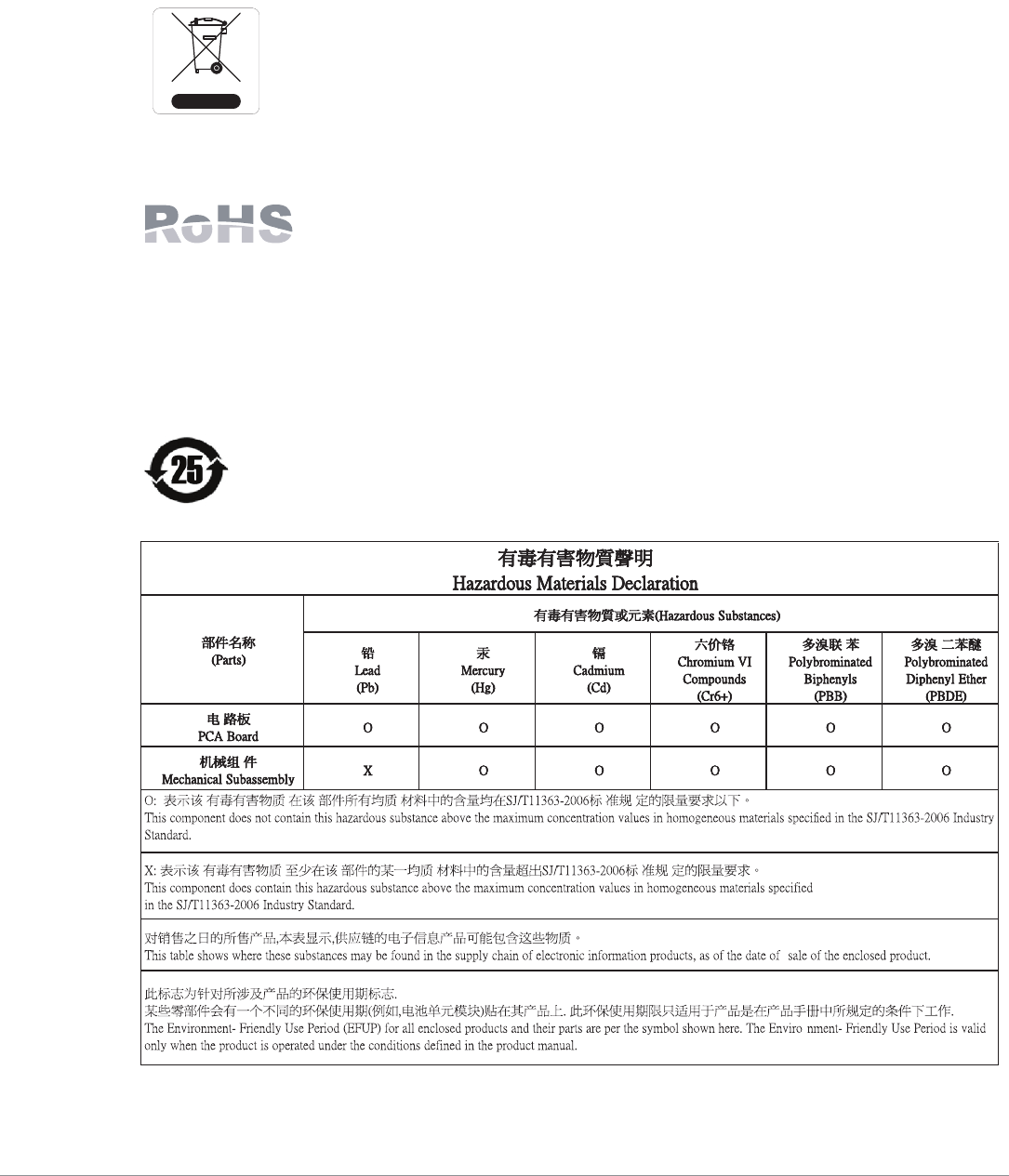
Aruba IAP-175 Outdoor Instant Access Point | Installation Guide 31
Proper Disposal of Aruba Equipment
For the most current information about Global Environmental Compliance and Aruba products, see our
website at www.arubanetworks.com.
Waste of Electrical and Electronic Equipment
Aruba products at end of life are subject to separate collection and treatment in the EU
Member States, Norway, and Switzerland and therefore are marked with the symbol
shown at the left (crossed-out wheelie bin). The treatment applied at end of life of these
products in these countries shall comply with the applicable national laws of countries
implementing Directive 2002/96EC on Waste of Electrical and Electronic Equipment
(WEEE).
European Union RoHS
Aruba products also comply with the EU Restriction of Hazardous Substances
Directive 2002/95/EC (RoHS). EU RoHS restricts the use of specific hazardous
materials in the manufacture of electrical and electronic equipment. Specifically,
restricted materials under the RoHS Directive are Lead (including Solder used in
printed circuit assemblies), Cadmium, Mercury, Hexavalent Chromium, and Bromine. Some Aruba products
are subject to the exemptions listed in RoHS Directive Annex 7 (Lead in solder used in printed circuit
assemblies). Products and packaging will be marked with the “RoHS” label shown at the left indicating
conformance to this Directive.
China RoHS
Aruba products also comply with China environmental declaration requirements and are
labeled with the “EFUP 25” label shown at the left.

32 Aruba IAP-175 Outdoor Instant Access Point | Installation Guide
Canada RF Compliance
This Class B digital apparatus complies with Canadian ICES-003.
Cet appareil numérique de classe B est conforme à la norme canadienne ICES-003.
This device complies with RSS 210 of Industry Canada.
Ce périphérique est conforme à la norme RSS-210 d'Industrie Canada.
Operation is subject to the following two conditions: (1) this device may not cause interference, and (2) this
device must accept any interference, including interference that may cause undesired operation of this
device.
L'utilisation de ce périphérique est soumise aux deux conditions suivantes : (1) ce périphérique ne doit pas
provoquer d'interférences, et (2) ce périphérique doit accepter toute interférence, y compris les
interférences susceptibles de provoquer un dysfonctionnement.
High power radars are allocated as primary users of the 5.25 to 5.35 GHz and 5.47 to 5.6 GHz and 5.65 to
5.725 GHz bands. These radar stations can cause interference with and/or damage this device.
Les radars haute puissance utilisent de façon prioritaire les bandes 5,25 - 5,35 GHz, 5,47 - 5,6 GHz et 5,65 -
5,725 GHz. Par conséquent, ces radars peuvent provoquer des interférences avec ce périphérique et
endommager ce dernier.
This device will not operate on channels which overlap the 5600 - 5650 MHz band.
Ce périphérique ne fonctionne pas sur les canaux qui utilisent la bande de fréquences 5 600 - 5 650 MHz.
This device must not be co-located or operated in conjunction with any other unauthorized antenna or
transmitter.
Ce périphérique ne doit pas être installé ou utilisé avec une antenne ou un transmetteur non homologués.
This equipment complies with IC radiation exposure limits and should be installed and operated with
minimum distance 20cm between the radiator and your body.
Cet équipement respecte les limites établies par IC en matière d'exposition aux rayonnements, et doit être
installé et utilisé en respectant une distance minimale de 20 cm entre l'élément rayonnant et votre corps.
TRA
REGISTERED No:
DEALER No:
DA0039425/10
ER0055290/11
200202320G

Aruba IAP-175 Outdoor Instant Access Point | Installation Guide 33

34 Aruba IAP-175 Outdoor Instant Access Point | Installation Guide

Aruba IAP-175 Outdoor Instant Access Point | Installation Guide 35
Contacting Aruba Networks
Web Site Support
Main Site http://www.arubanetworks.com
Support Site https://support.arubanetworks.com
Software Licensing Site https://licensing.arubanetworks.com/login.php
Wireless Security Incident
Response Team (WSIRT) http://www.arubanetworks.com/support/wsirt.php
Support Emails
Americas and APAC support@arubanetworks.com
EMEA emea.support@arubanetworks.com
WSIRT Email
Please email details of any security
problem found in an Aruba product.
wsirt@arubanetworks.com
Telephone Support
Aruba Corporate +1 (408) 227-4500
FAX +1 (408) 227-4550
Support
United States 800-WI-FI-LAN (800-943-4526)
Universal Free Phone Service Number
(UIFN): Australia, Canada, China,
France, Germany, Hong Kong, Ireland,
Israel, Japan, Korea, Singapore, South
Africa, Taiwan, and the UK.
+800-4WIFI-LAN (+800-49434-526)

Copyright
© 2010 Aruba Networks, Inc. AirWave®, Aruba Networks®, Aruba Mobility Management System®, Bluescanner, For
Wireless That Works®, Mobile Edge Architecture, People Move. Networks Must Follow., RFprotect®, The All
Wireless Workplace Is Now Open For Business, and The Mobile Edge Company® are trademarks of Aruba
Networks, Inc. All rights reserved. All other trademarks are the property of their respective owners.
Open Source Code
Certain Aruba products include Open Source software code developed by third parties, including software code
subject to the GNU General Public License (GPL), GNU Lesser General Public License (LGPL), or other Open Source
Licenses. The Open Source code used can be found at this site:
http://www.arubanetworks.com/open_source
Legal Notice
The use of Aruba Networks, Inc. switching platforms and software, by all individuals or corporations, to terminate
other vendors' VPN client devices constitutes complete acceptance of liability by that individual or corporation for
this action and indemnifies, in full, Aruba Networks, Inc. from any and all legal actions that might be taken against it
with respect to infringement of copyright on behalf of those vendors.
Warranty
This hardware product is protected by the standard Aruba warranty of one year parts/labor. For more information,
refer to the ARUBACARE SERVICE AND SUPPORT TERMS AND CONDITIONS.
Altering this device (such as painting it) voids the warranty.
www.arubanetworks.com
1344 Crossman Avenue
Sunnyvale, California 94089
Phone: 408.227.4500
Fax 408.227.4550
36 Aruba IAP-175 Outdoor Instant Access Point | Installation Guide
All Other Countries +1 (408) 754-1200
Telephone Support